ALLIGATOR
BEHAVIOR page 2i: SOCIAL SIGNALS AND BELLOWING 9 1 2
3
4
5
6
7
8
10
This
page was born 07/03/2021. Rickubis designed it.
(such as it
is.) Last update: 08/24/2023
Images
and contents on this page copyright © 2001 - 2023 Richard M.
Dashnau
Alligators,
although they are ectothermic and also equipped with a small
brain,
exhibit
a surprising diversity in their responses to their environment
and to
each
other. They
are for more complex than mere animated logs or 12-foot-long
eating machines. This group of pages show some of what I've been
able
to
see in the years I've been
volunteering (September of 2001 thru August of 2023) at Brazos
Bend
State
Park.
From Brazos Bend State Park
on 10/23/2022
I
was watching the mom alligator near the observation tower,
looking
for some sign of the hatchlings. I thought I heard
an
alligator bellowing in 40 Acre Lake, but but I couldn't be
sure over
the sound of the wind. But the mom gator moved to a
shallower
spot, and prepared to bellow. After a few false starts,
she bellowed for a full bout. Most of the events in
this
article appear
in
this video. marker
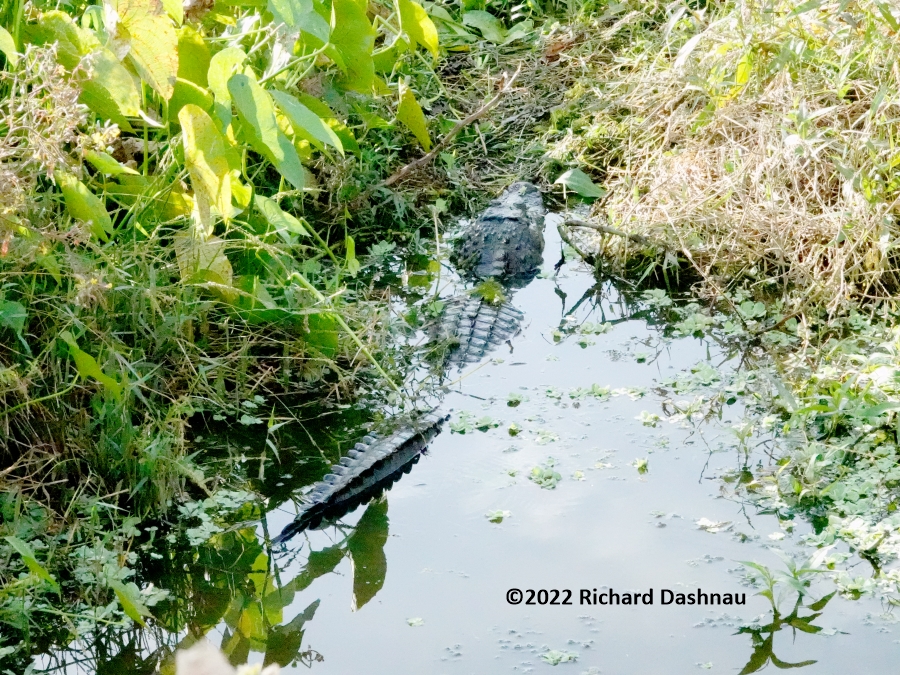
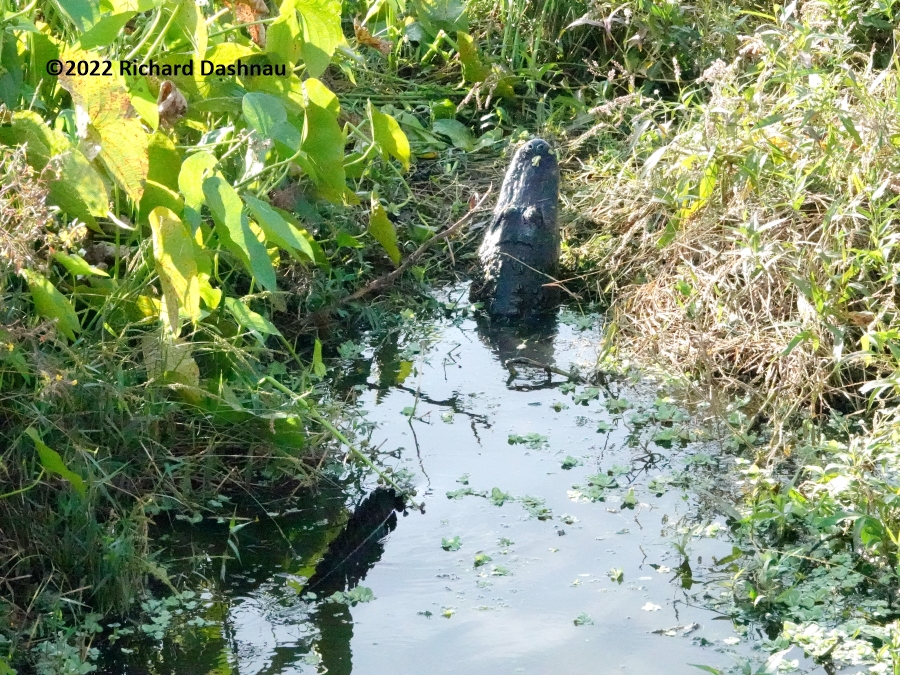

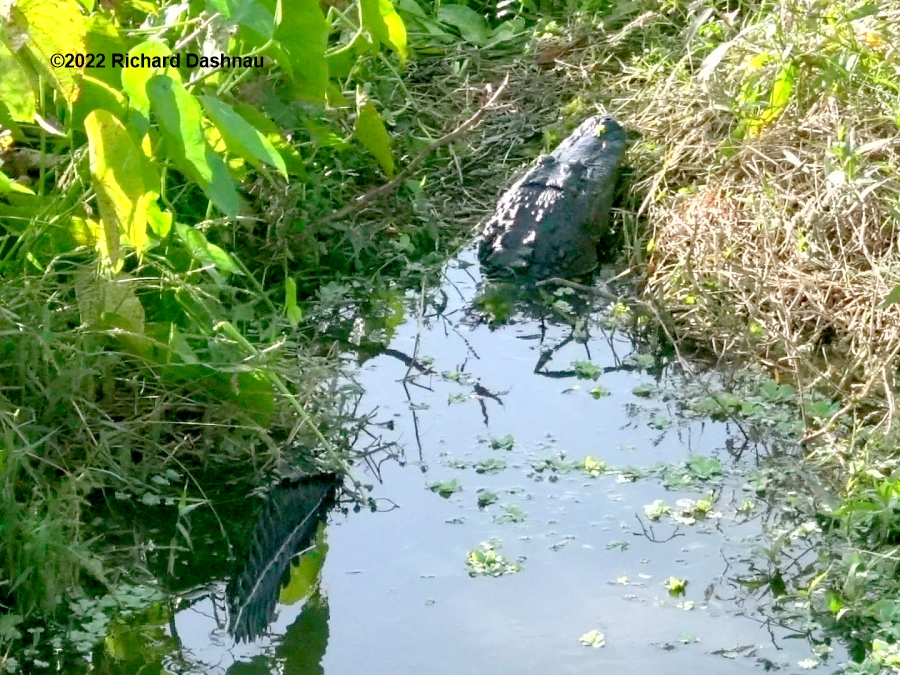
When
I watched the video, I noticed something interesting. All
the gator
literature I've seen says that only male alligators send out
the
Subaudible Vibrations
(SAV) during bellowing. I've
filmed it. The alligator's back vibrates independently and
produces
Faraday waves--the "water dance". What we can see here is
some kind of
disturbance, but
it is not that prominent. This water disturbance
could be from the vibration of the bellow sound
resonating in
the
lungs and chest and being transferred to the water.
Or,of
course, I could
be wrong.
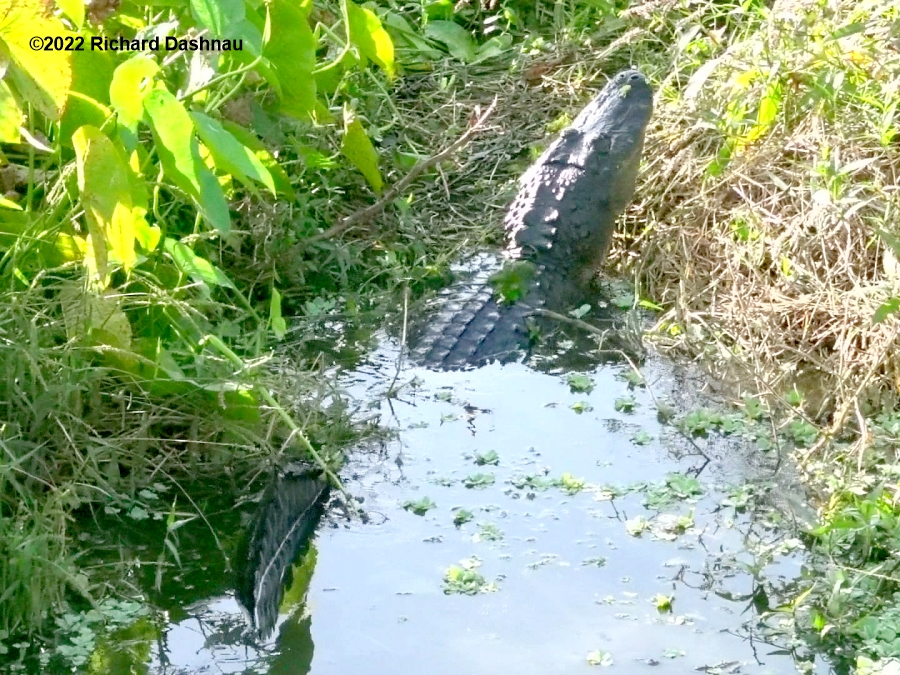
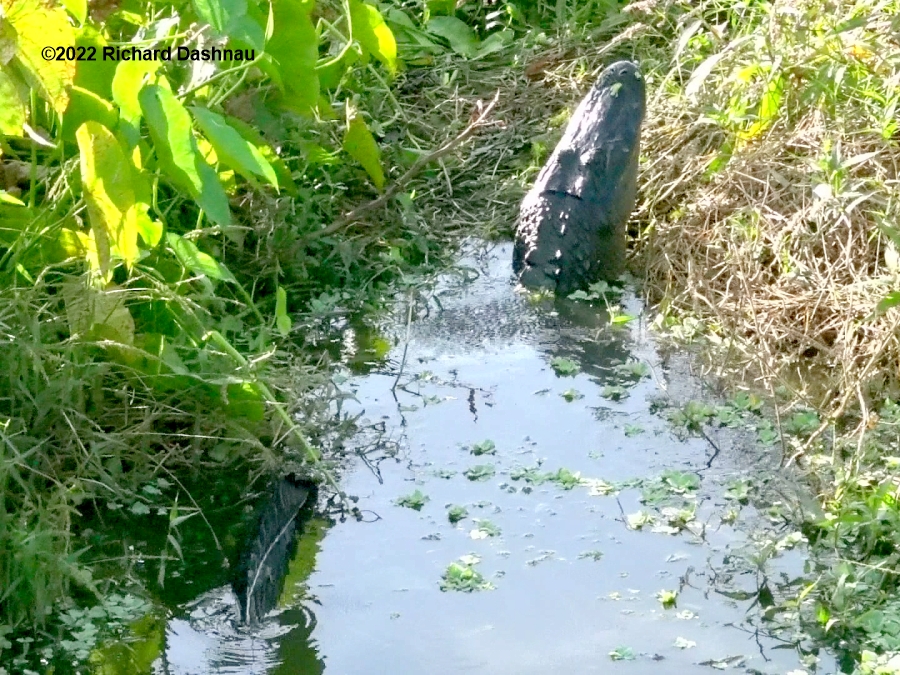
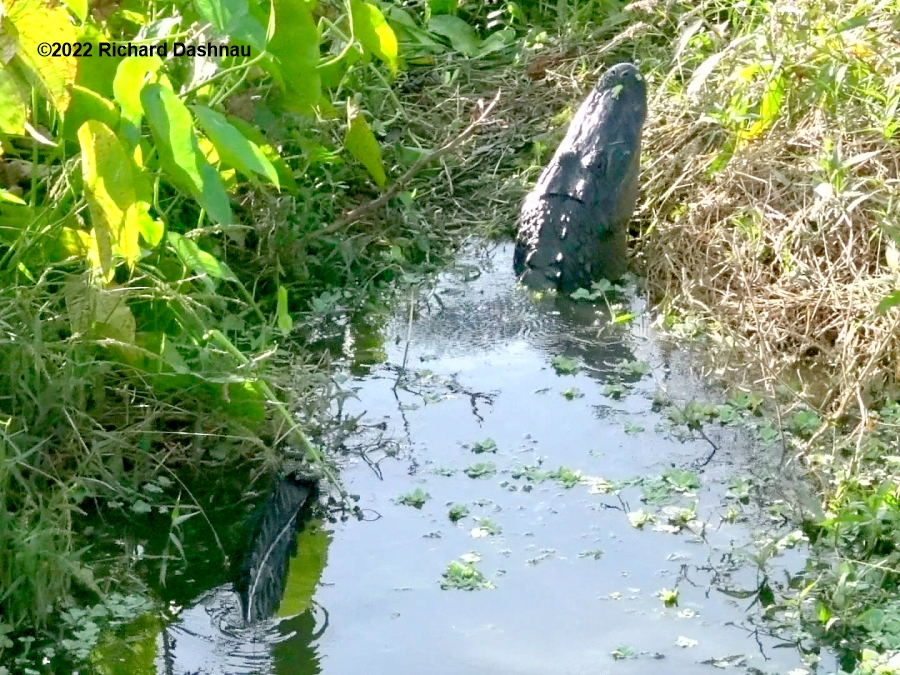
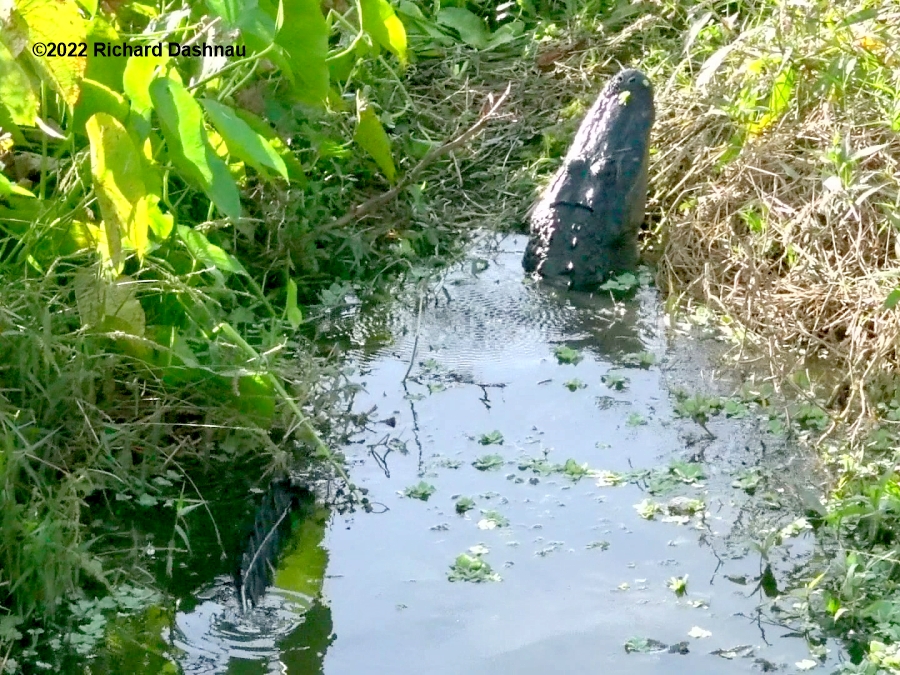
I show examples of waves in a male gator's
water-dance for comparison in images below. A definite
difference is visible. This video from 2009 shows some
bellows in slow motion. and
This
clip from 2013 shows a chorus
of bellows. (I also added a few clips to compare with the
new footage
in the video
for today. The
images below show 4 bellows taken at BBSP at different
times.
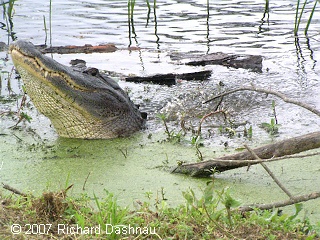
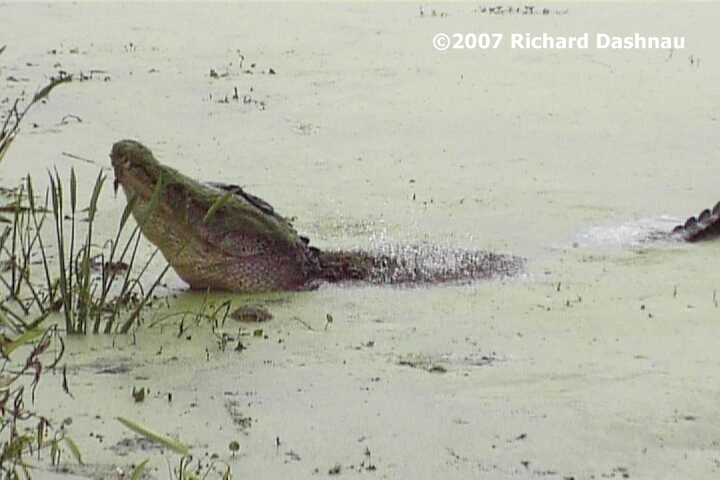
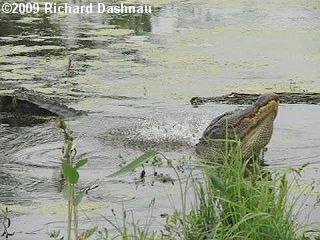
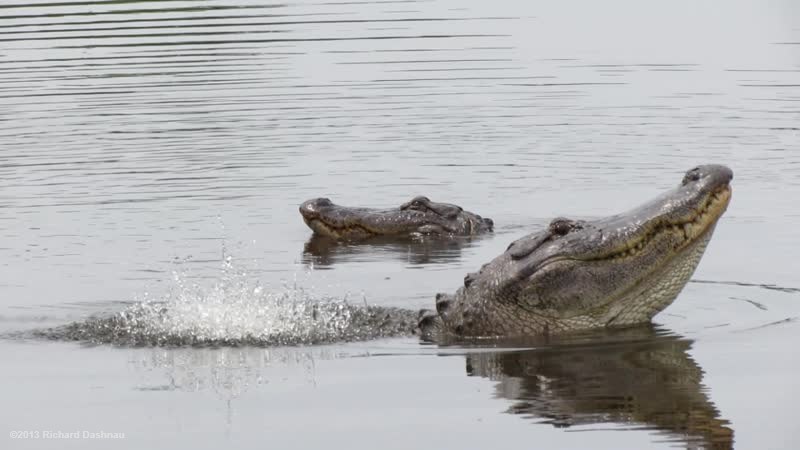
2007
2007
2009
2013
A 2017 study ("Formants provide honest acoustic cues to body
size in American alligators" -Reber, Janisch et.al. suggests
that the
audible component of bellows can give broadcast an "honest"
indication
of an alligator's size because the organs which create the
sound grow
with the gator and affect sections of the audio signal
("formants"). Since only the males produce the Faraday wave
SAV
broadcast (usually preceding the "roar"), listening
alligators
could tell
if the bellower is male or female when they pick up the SAV
with the
ISO
dots on their faces. ISOs (aka DPRs) are
tiny
sensor nodules on the scales of the lower jaw and upper lip
that can
sense pressure waves, and possibly other conditions. ISO =
Integumentary Sense Organ; DPR = Dome Pressure Receptor
Other gators bellowed in 40 acre
lake. The chorusing started about 9:15, and then lasted,
on-and-off about 20 minutes (9:35)
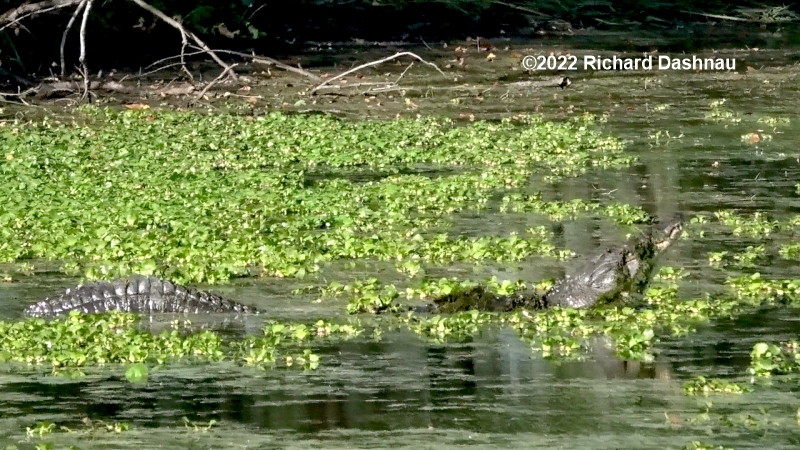
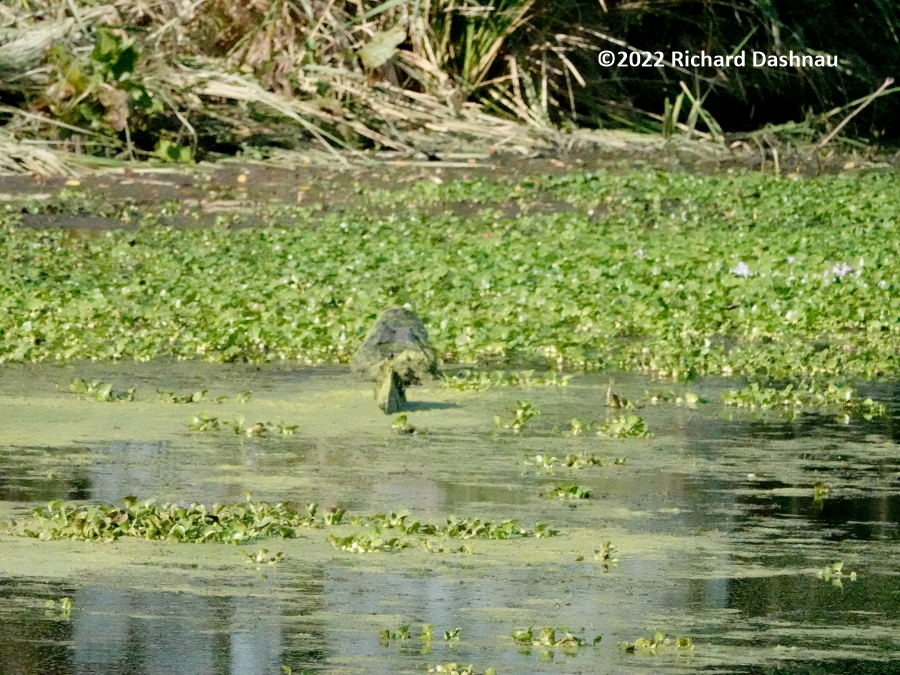
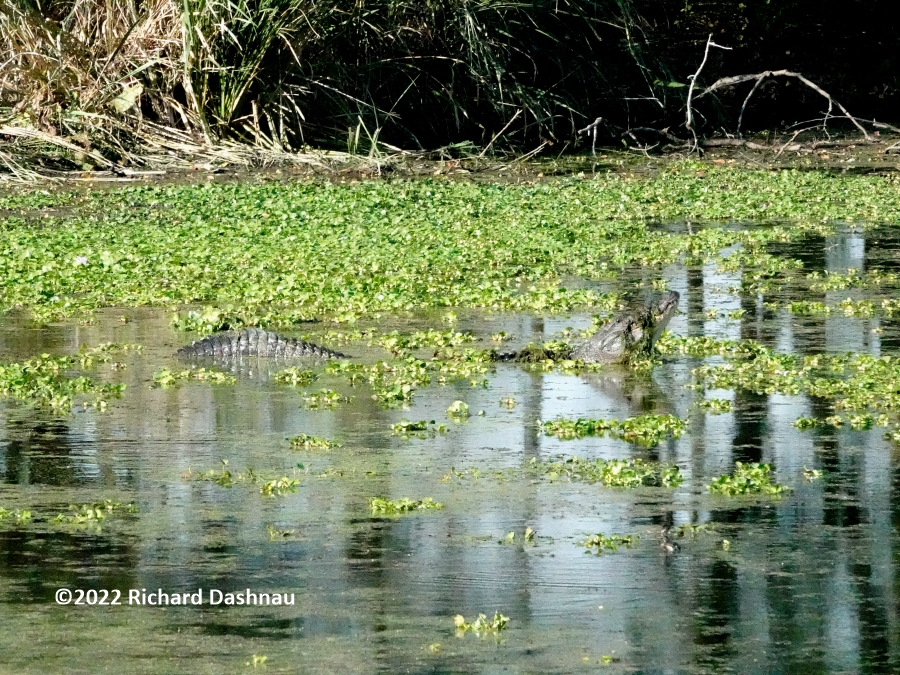
I
stayed in the area, interpreting for the folks coming
by, and
watching the mom gator and looking out at 40 Acre lake for
more action.
About 10:00, an alligator came into view, walking on the
currently-dry
area behind the Pilant Slough channel--over where the feral
hogs had
chopped up the ground. The gator proceded as usual when
walking over a
long, dry path; about 20 steps,
then rest--repeat. I didn't count
steps (since I was still interpreting) but I did time the
pauses-they
were only about 4 minutes long. I knew that
the alligator
intended to cross the trail and enter
40Acre lake, so when it
stopped in the trees near the trail, I brought the group of
visitors
over to wait
for the crossing.
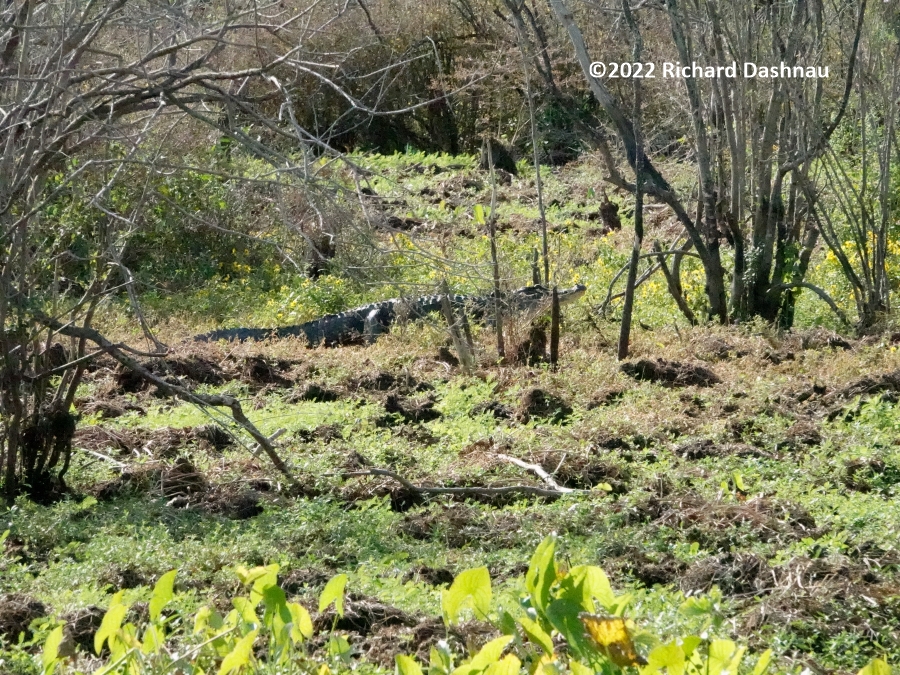
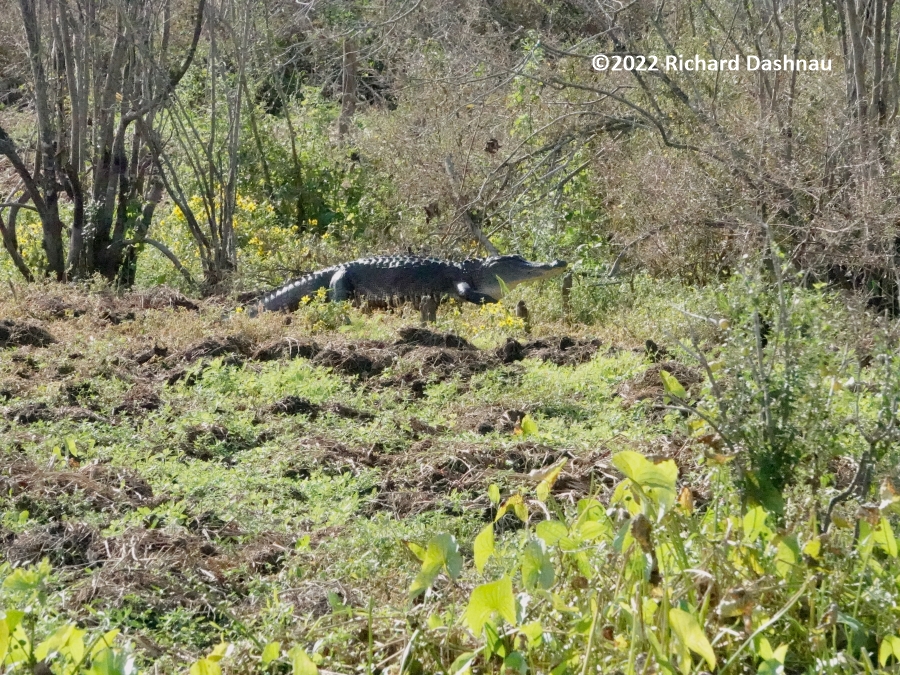
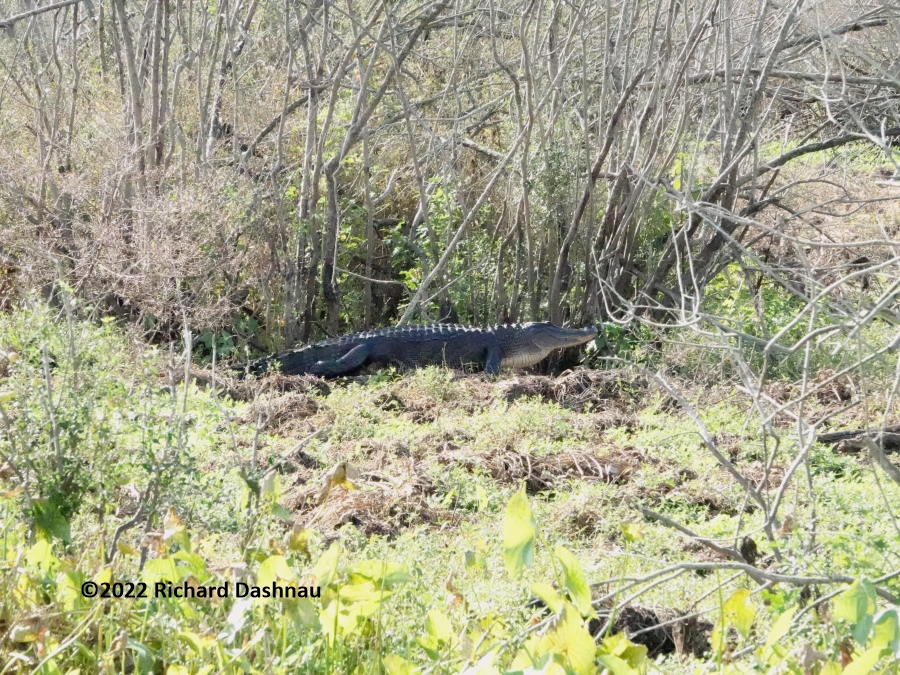
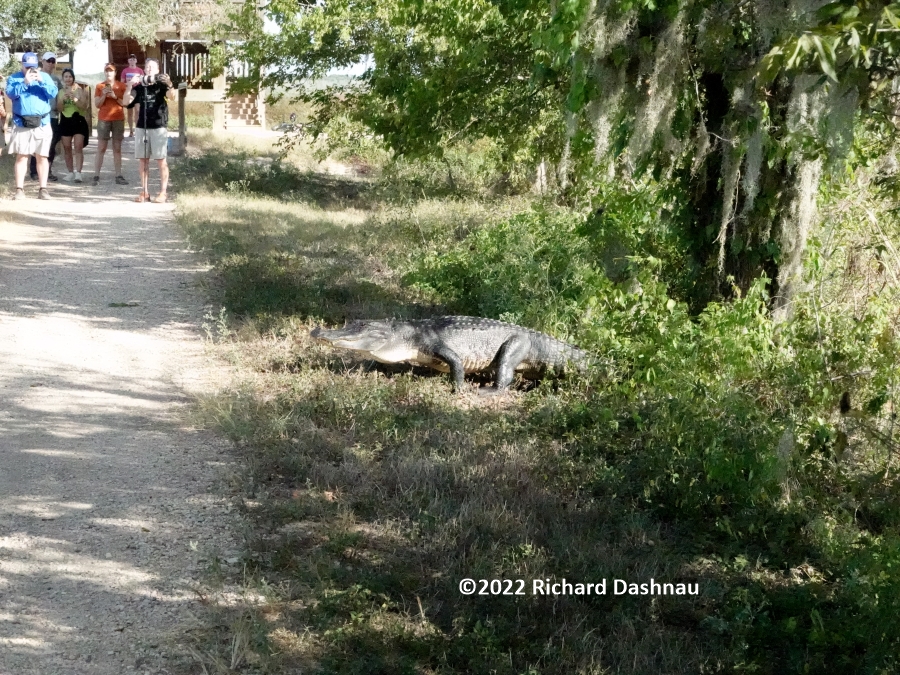
We staged on both sides of the path the gator
would take, and I kept a wide area open so the gator
wouldn't be
intimidated and give up. The
gator climbed onto the trail and rested at the
edge (as they often do)
for a few minutes, then got up and crossed. I
suggest that the alligator
that crossed had heard the mom gator bellowing
earlier and
took
a long, tiring detour over land
to avoid her. I
talked to the visitors, and demonstrated the width of the
trail
with my walking stick (6 feet) and showed they could
use that
dimension
to estimate the length of the gator in any
images
they'd caught of the
crossing. The trail was 6 feet wide, and the gator was about
1-1/2
times the trail width (2nd picture below), so the gator was
about 8 or
9 feet long.
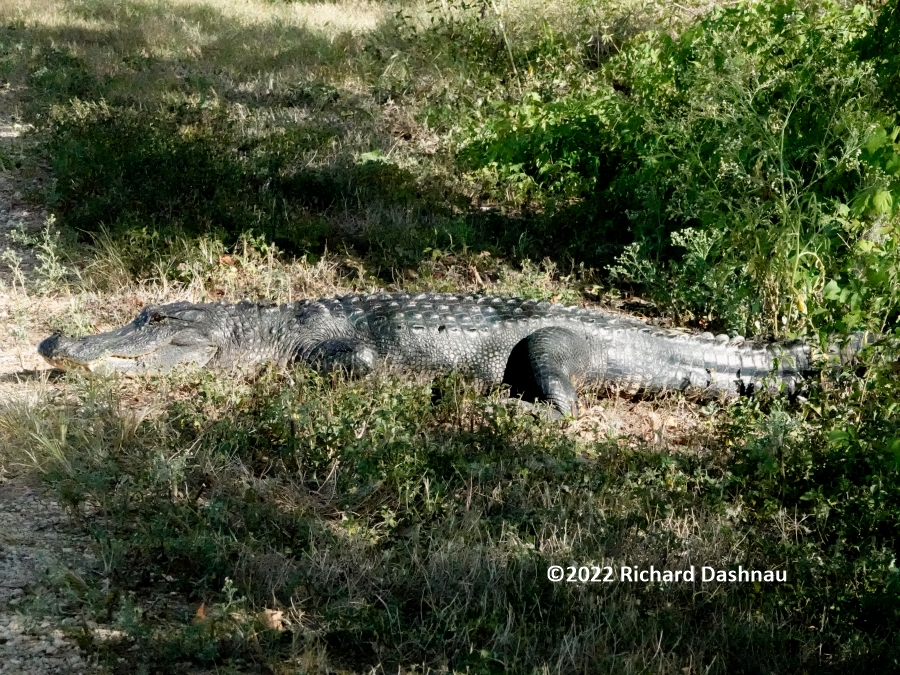
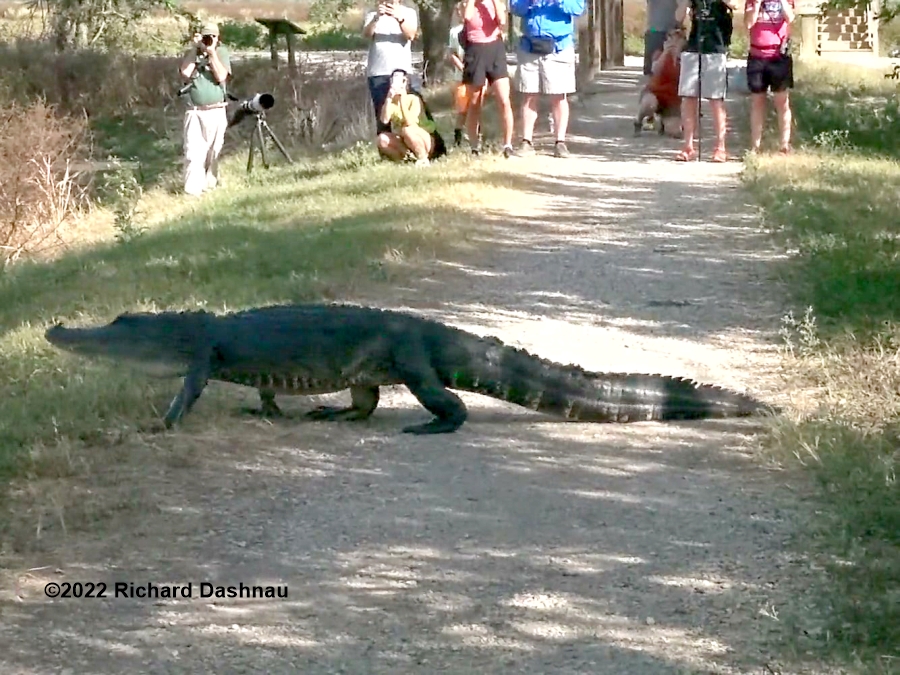
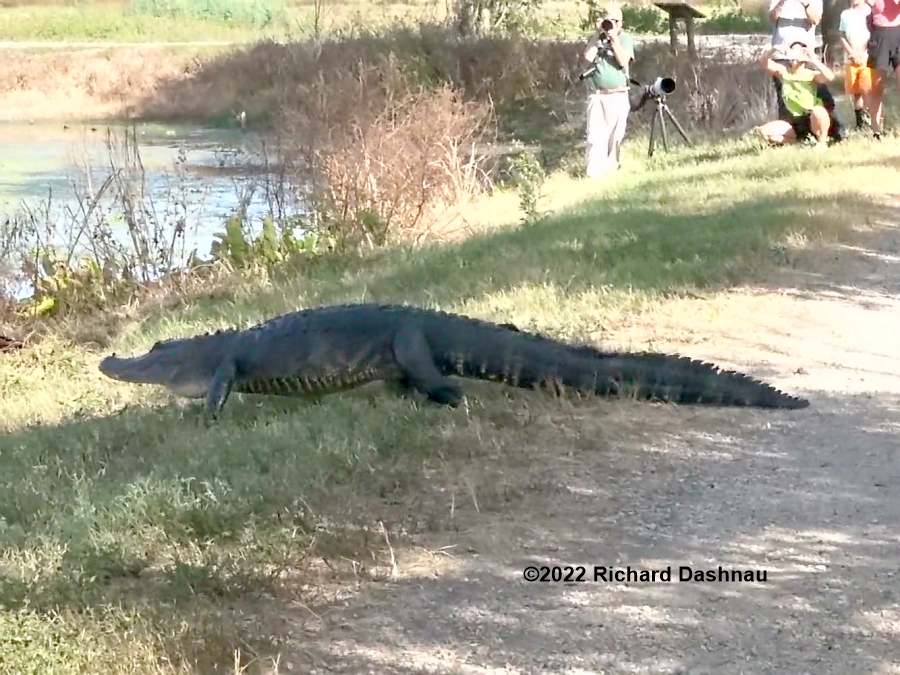
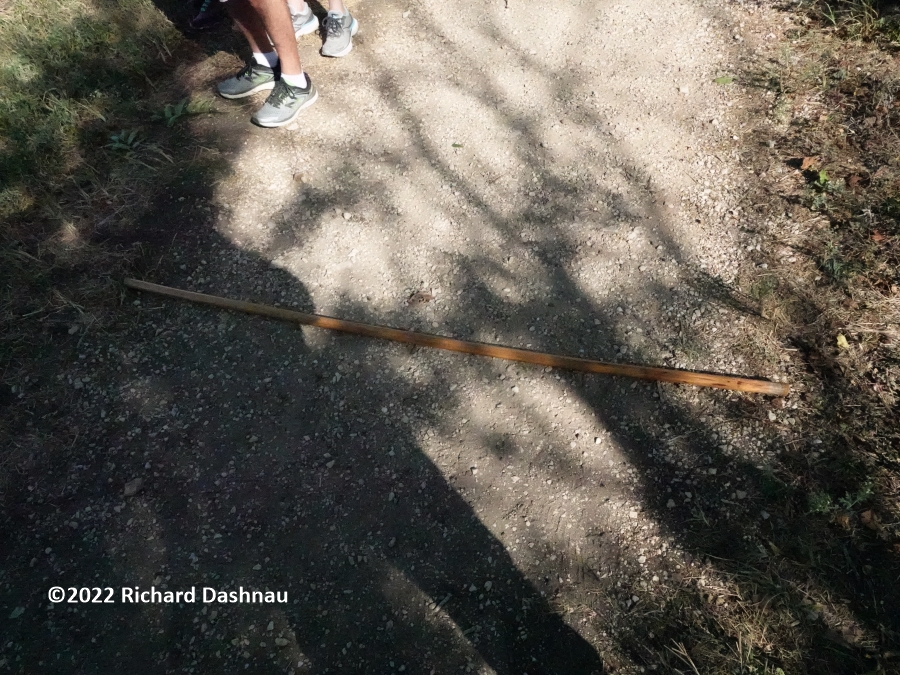
Then back at the
mom gator to watch for babies (I'd been hearing them,
but
hadn't found any yet). About 20 minutes after the gator
crossing, one
baby moved across moms snout. But I had
to wait another
hour until I could finally pick out the babies hiding among
the
plants.
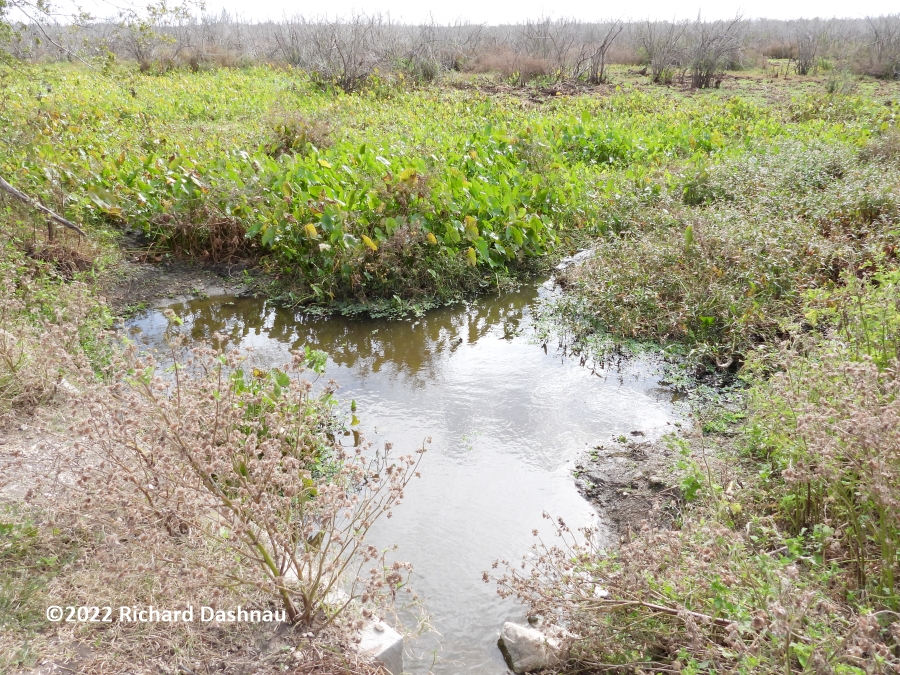
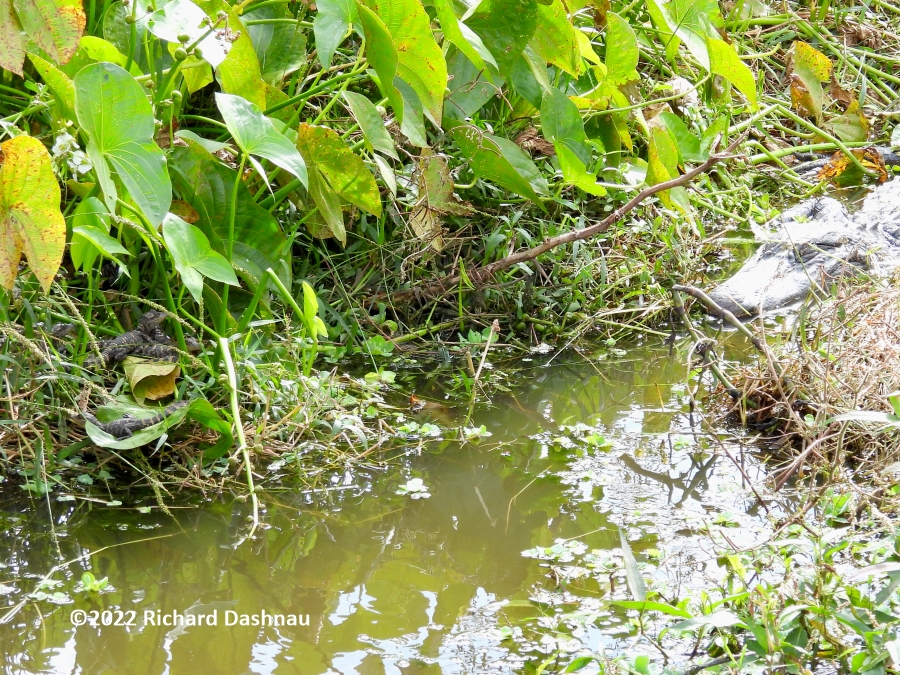
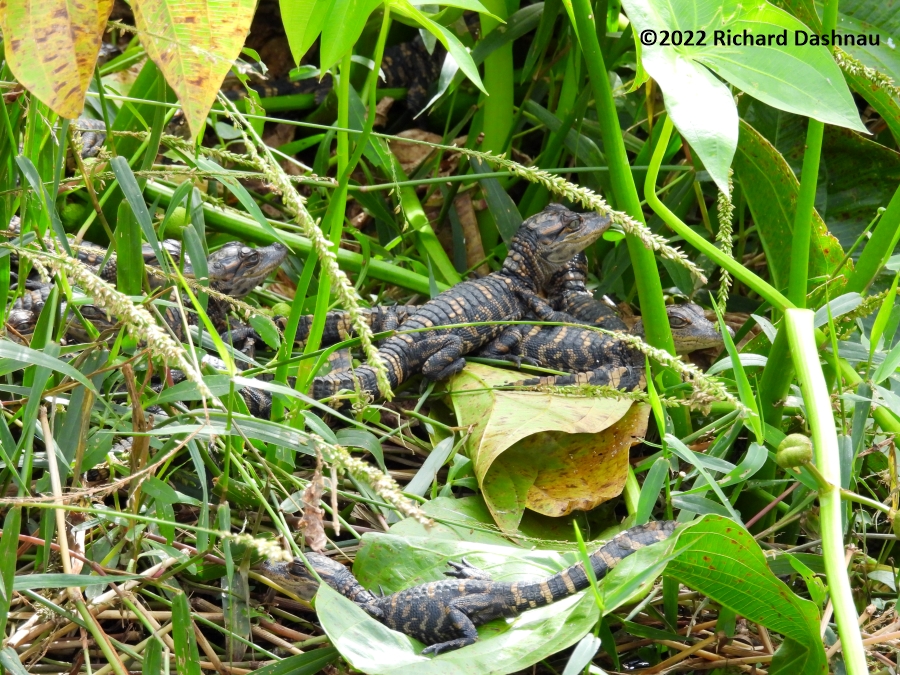
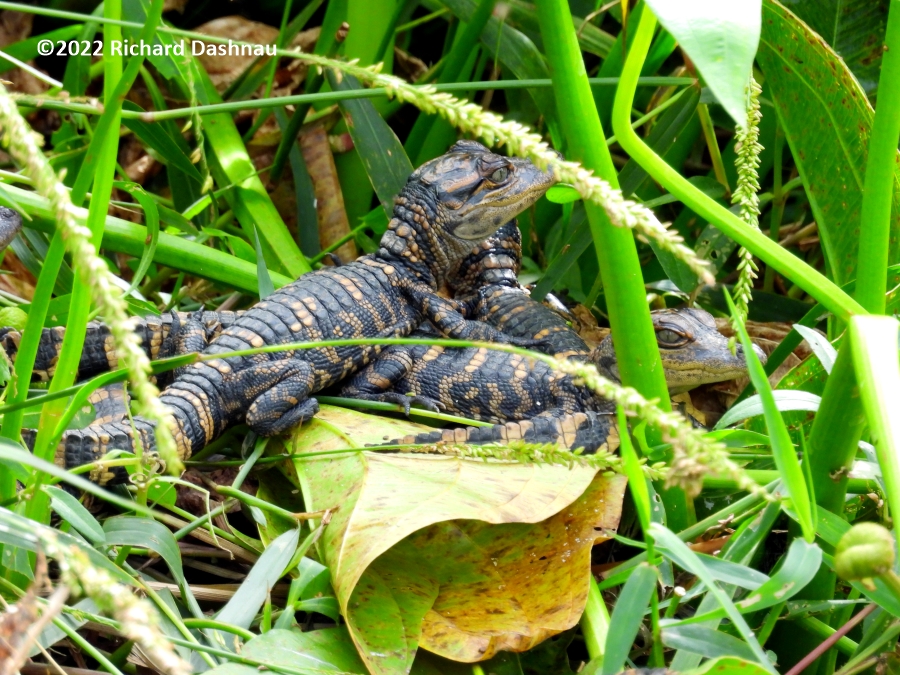
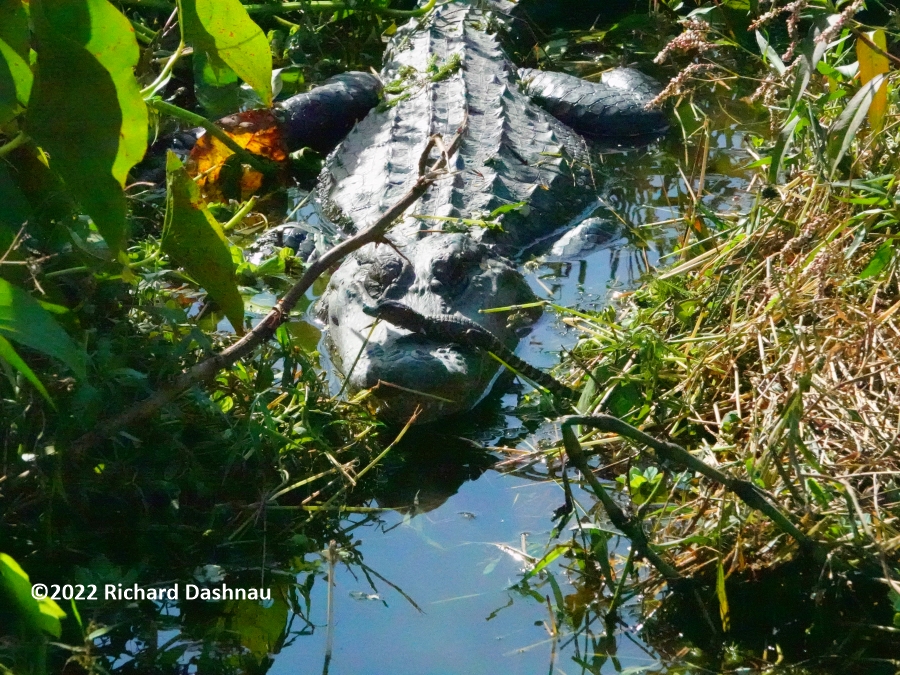
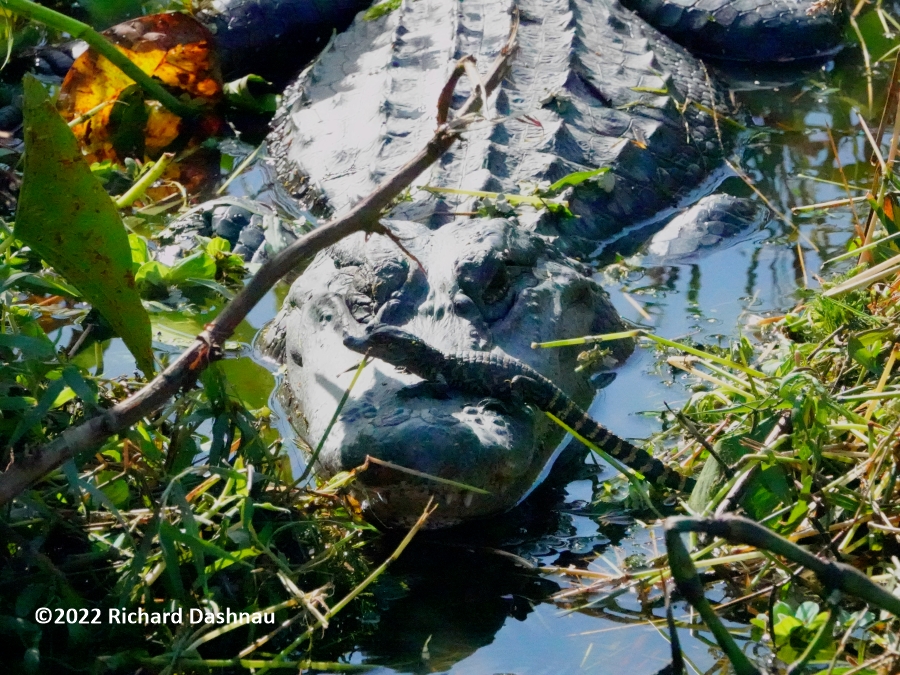
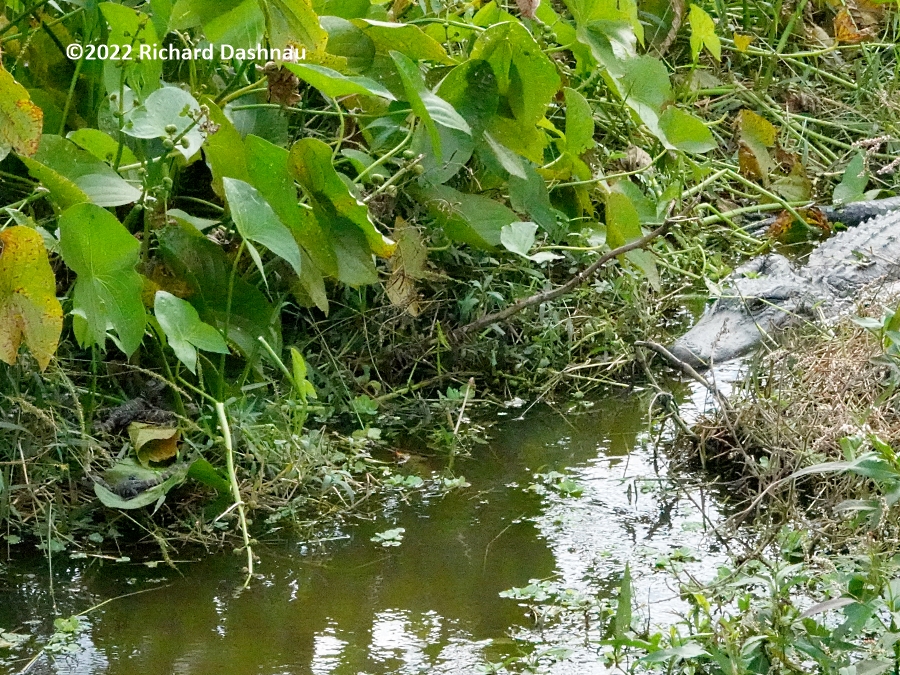
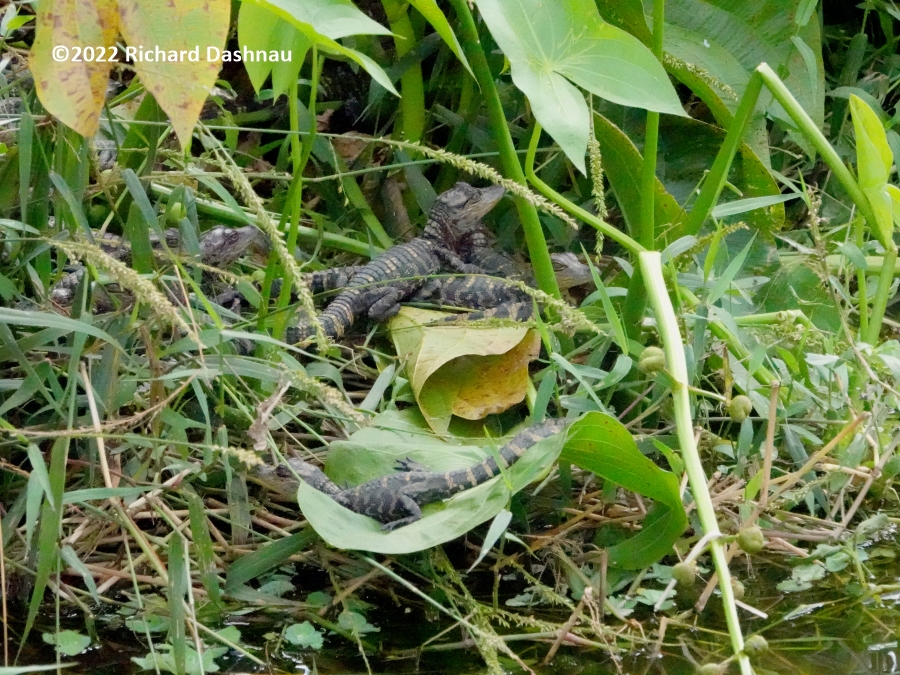
03/06/2022. Around
8am, the air was 72°
F-compared to 34°
F a week before!
I had just gotten to the
West edge of 40 Acre Lake when I saw and heard
this alligator bellowing
in Pilant Lake. The alligator was
about 20 yards away. I shot photos and video, but was
filming
into the breeze, so the wind noise drowned out the bellowing in
the
captured video. Judging by the sounds, and no vibration ripples
I think
this was a female. Beautiful gator! The first two
images
show the expansion of the area under her jaw while she's
calling.
The
other four images show her making a slight gape at the end of
her bout.
I've seen other alligators do this at the end of a
bout--but
I'll
have to go back over all of my gator social signal literature
to see if it's mentioned. The gape is not very wide, and the
jaws
leisurely closed as she brought her snout down to the water.
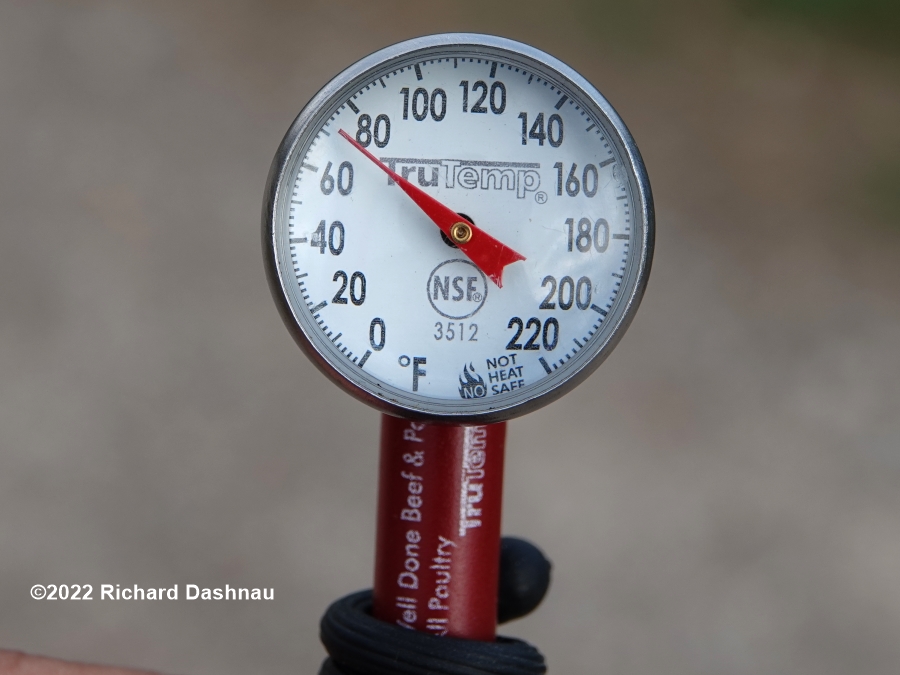
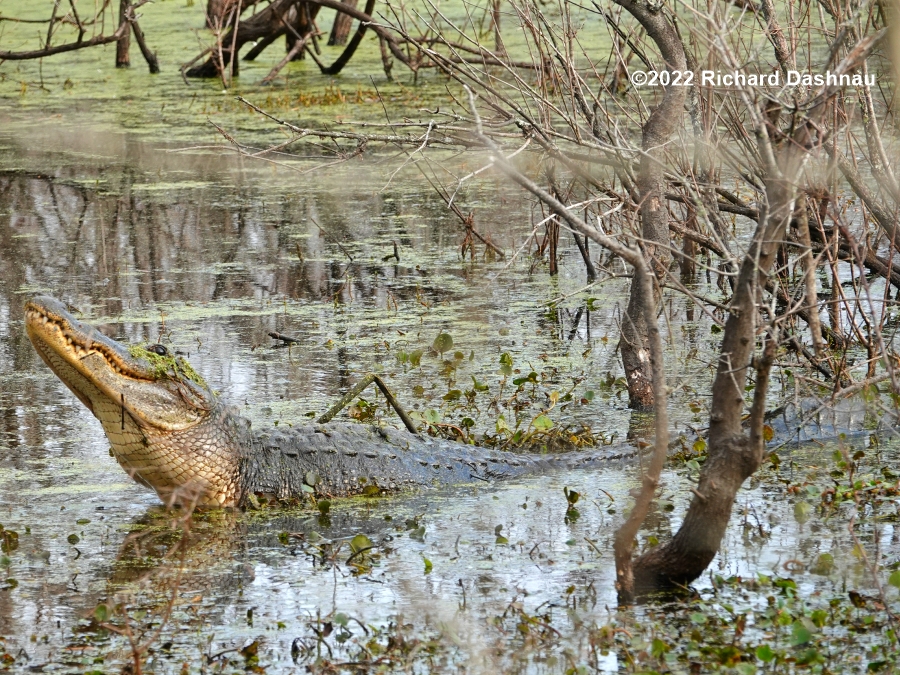
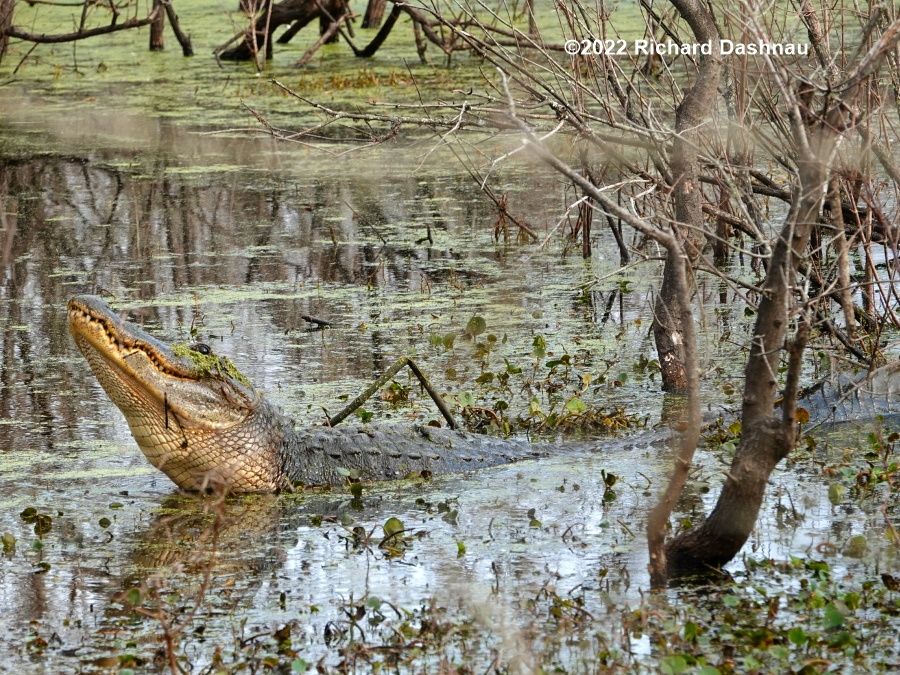
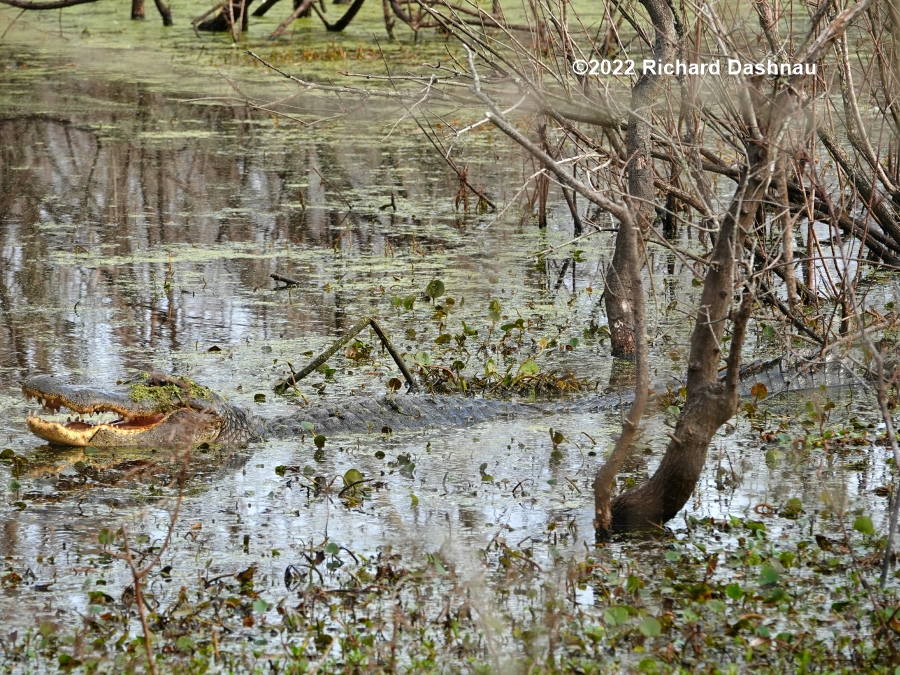
Look at that temperature! 8:32am
Gape
after the bellowing bout.
Below
are
last two images showing her gently lowering her face into the
water. About 5 minutes later, another alligator started
bellowing in 40 Acre Lake! That one was only 50 yards from
the
first
one, but a bit further East, and near one of the islands in 40
Acre
lake. I had already walked past it, so I was maybe...60
yards
from it. I think this one was also female It was a longer shot
for me, so video didn't capture the sound of her
bellows,
either. Alligator mating season generally lasts March -
May.
The alligators at BBSP were ready to start.
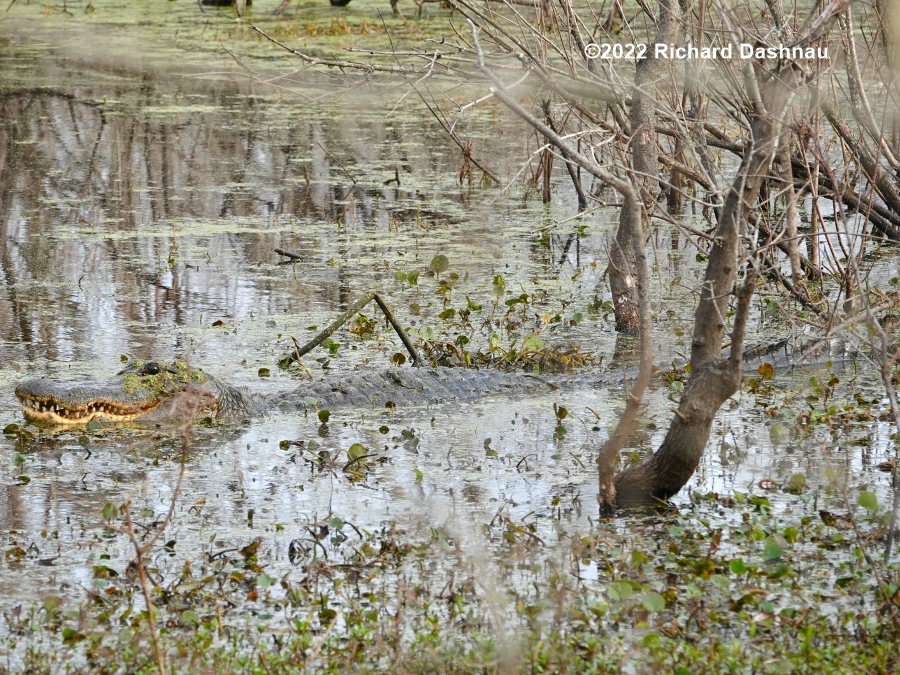
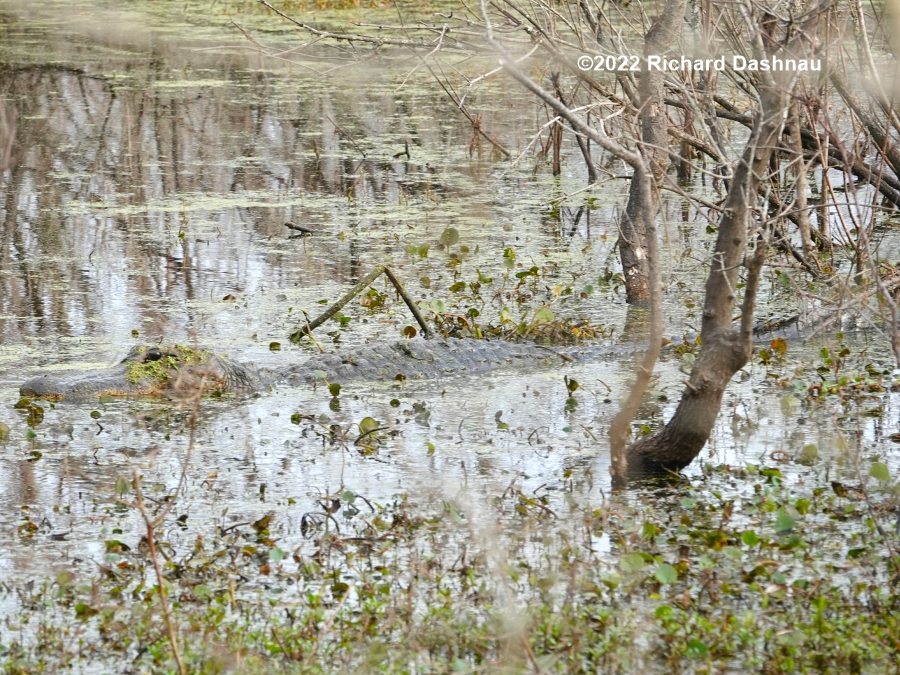
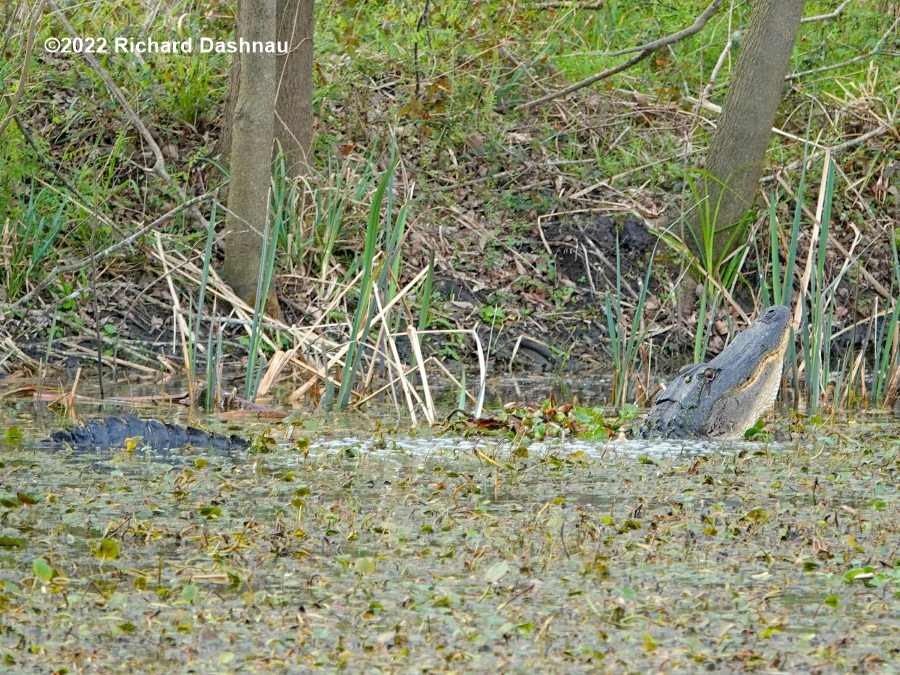
09/05/2021 I
had witnessed some other events-including a Great Blue Heron eating a
siren(shown on another page).When the heron had finished, I went back
to look at
the gator by
nest#5 (nest described on this
page.) and talked to more visitors. At about 9:30 another
large alligator swam by the one in front of the nest,
and parked about 4 feet to the left and parallel
to the first one. NOW
what? In a few minutes, the newcomer started to
bellow! After a
couple more minutes (and a group of bellows), the alligator on the
right started bellowing! Water danced
over
the alligator on the
right, so I knew it was a male. It didn't dance on the left
alligator, so I assumed it was female. There chorus
lasted
about 5 minutes,
and at the end another alligator
bellow a few times--but it was
right next to us! I hadn't even known it was there, and it
was at
least 6 feet long. About 10 or 15 visitors watched
the display
with me, and although I shot video,
the distance, and the
people(including me) talking covered over most of the
bellowing. The video can
be seen here (mp4).
But
what happened here?
After
watching the video, and thinking a bit, I have an informed (by
knowledge of gators) guess.
I
had assumed that the original alligator was the owner of the nest,
since it had been facing the bank. I'd also assumed that baby
alligators were hidden somewhere in there, since
the nest had been
opened. But the alligator that moved in from the right, circled past
the first alligator and then started bellowing was probably a female
(I.D. by no back vibrations,
low sound). The first alligator was
male (judging by the visible back vibrations). As the
bellowing
continued, the female moved closer to the male, and eventually got
between it and
the island. I think that the female (which had
started bellowing first) was the owner of the nest, and that it was
trying to move the male away from the nest and from any babies that
might
have been hidden there. The male did leave after the last bellows. I
wish I'd thought of this while I was there, and interpreting for the
park visitors. At the time, I was surprised
by the events.
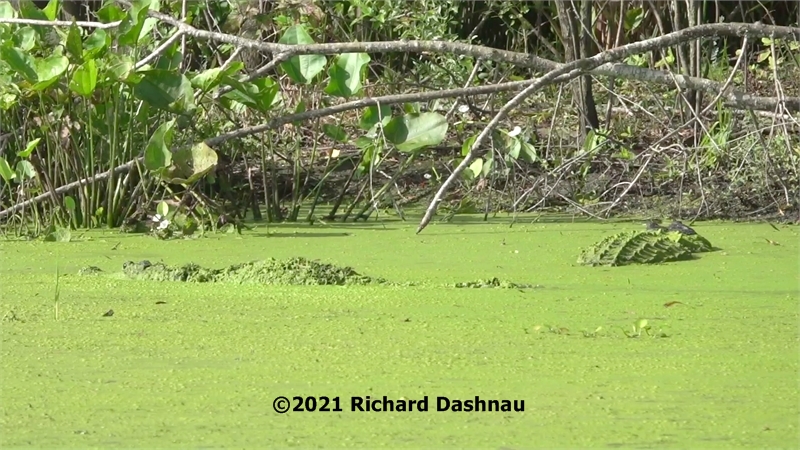
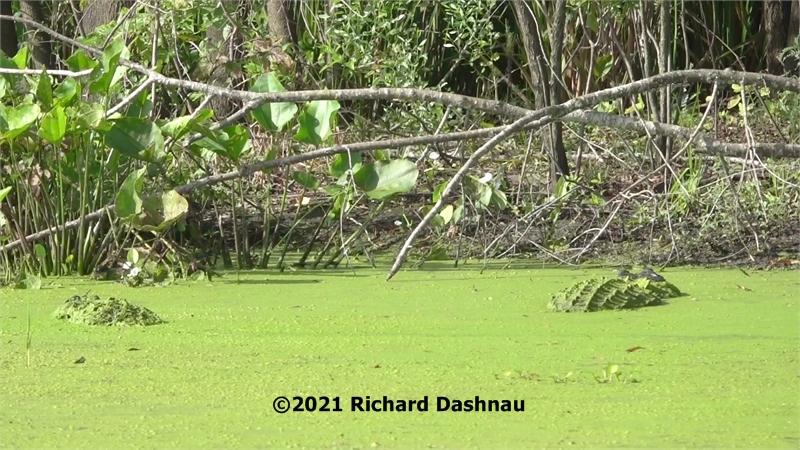
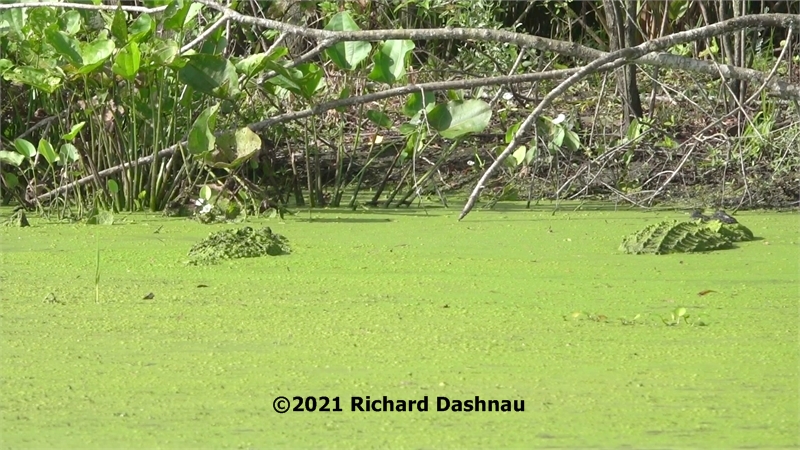
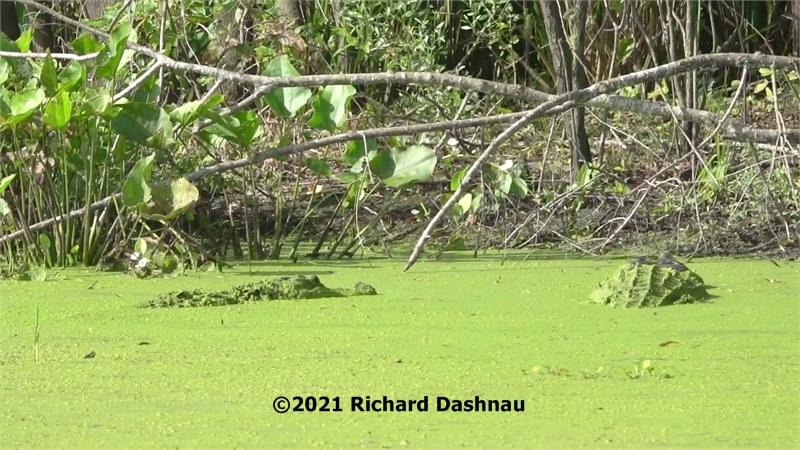
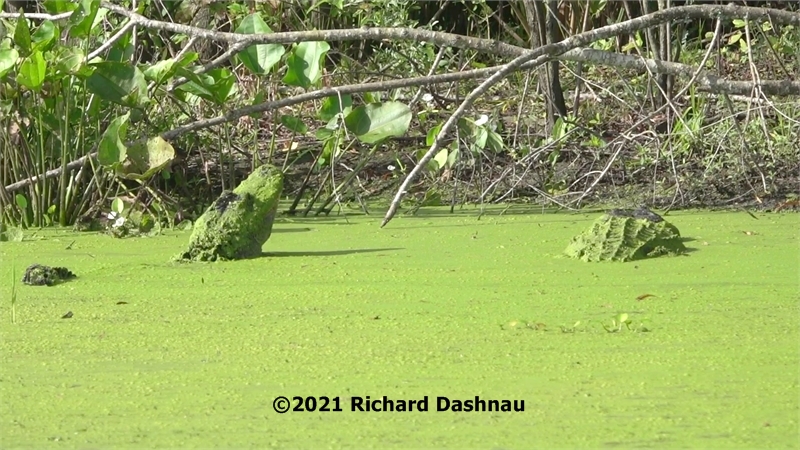
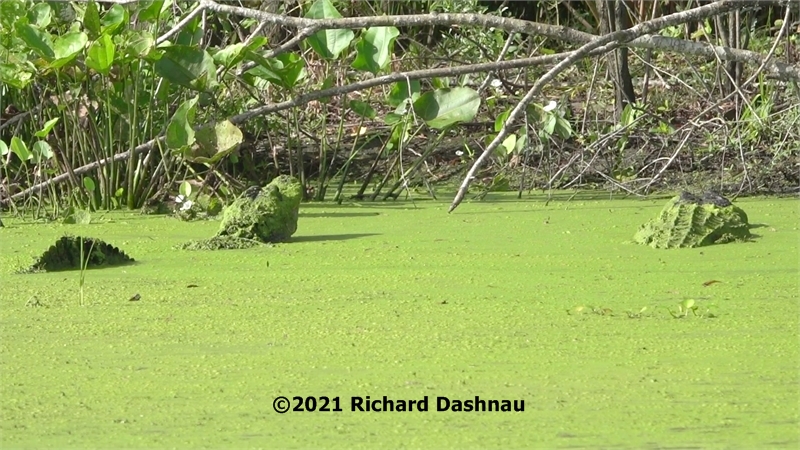
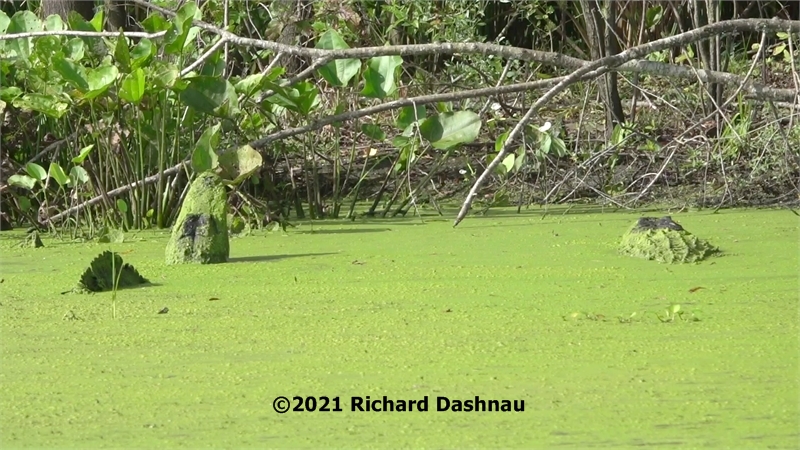
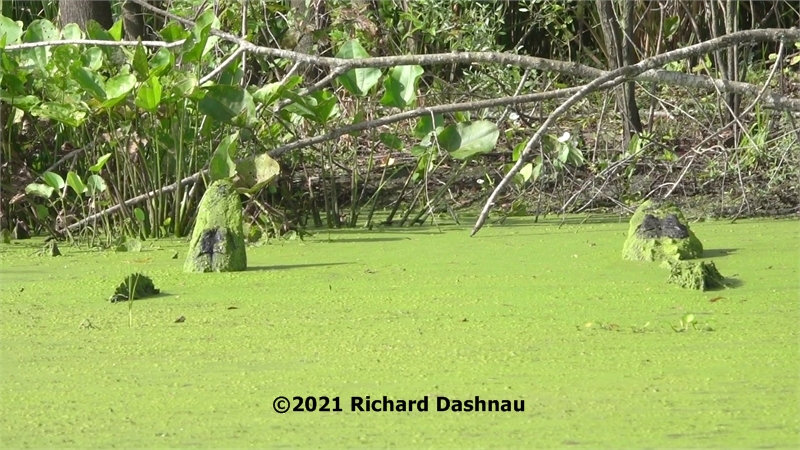
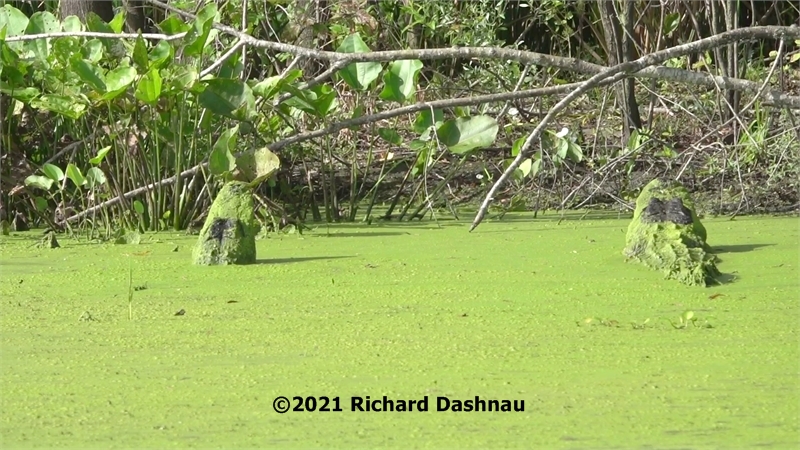
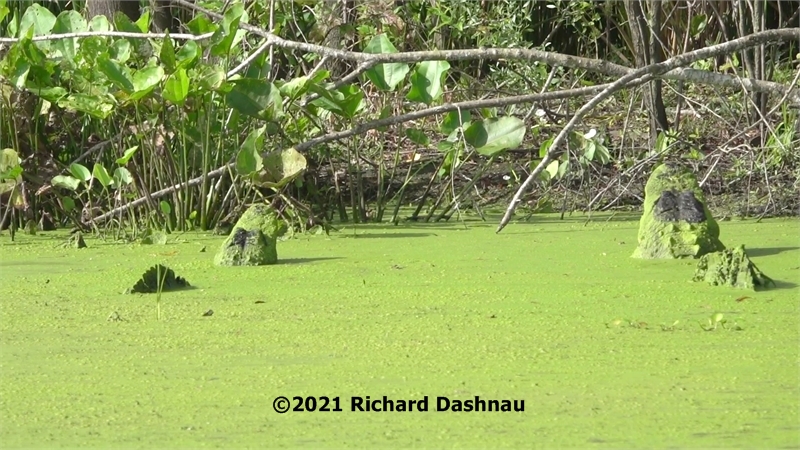
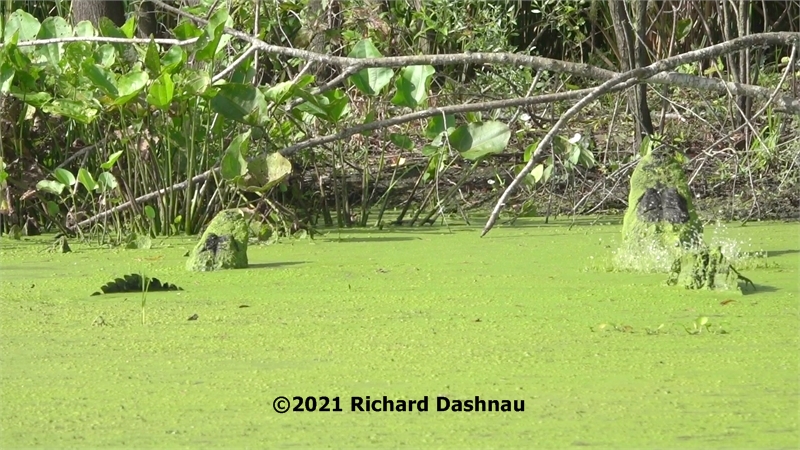
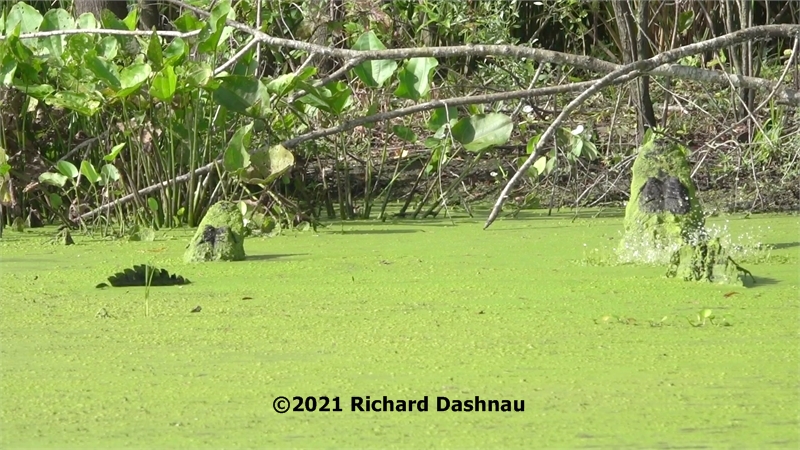
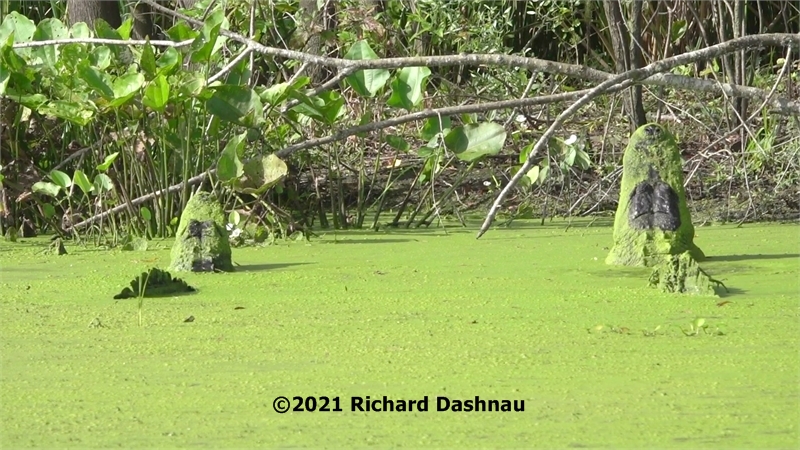
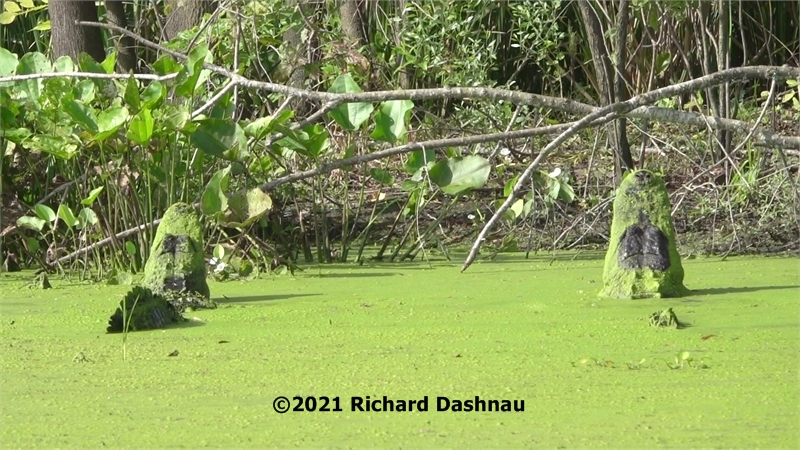
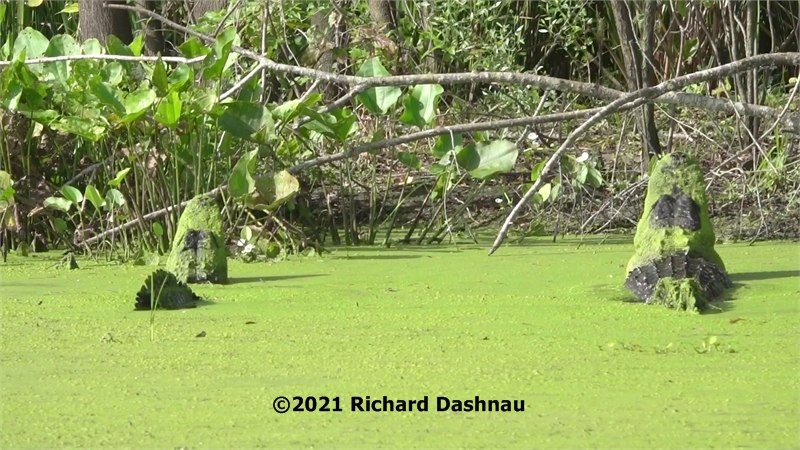
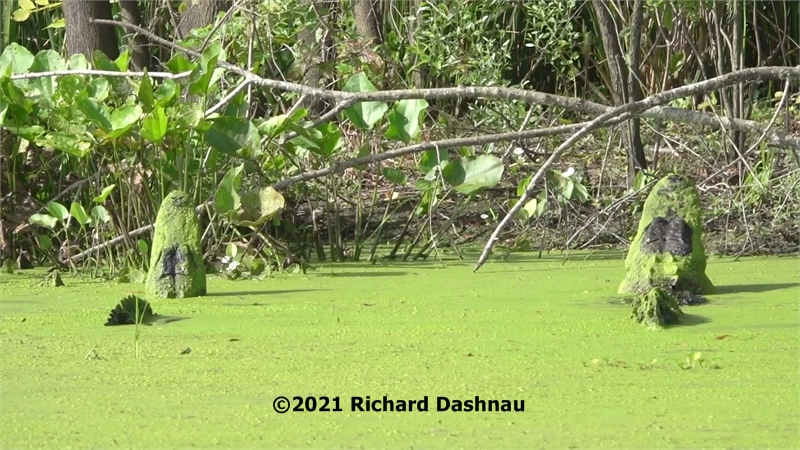
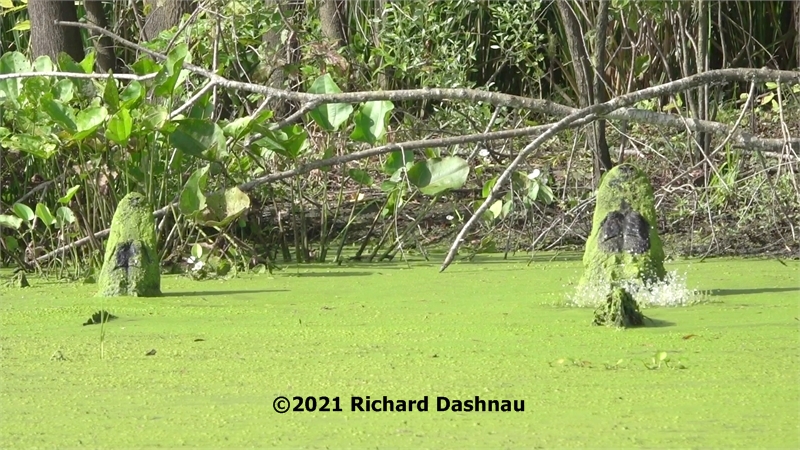
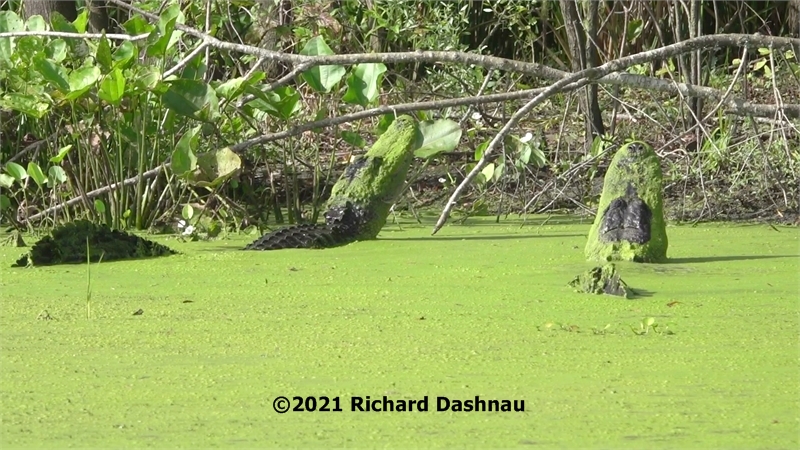
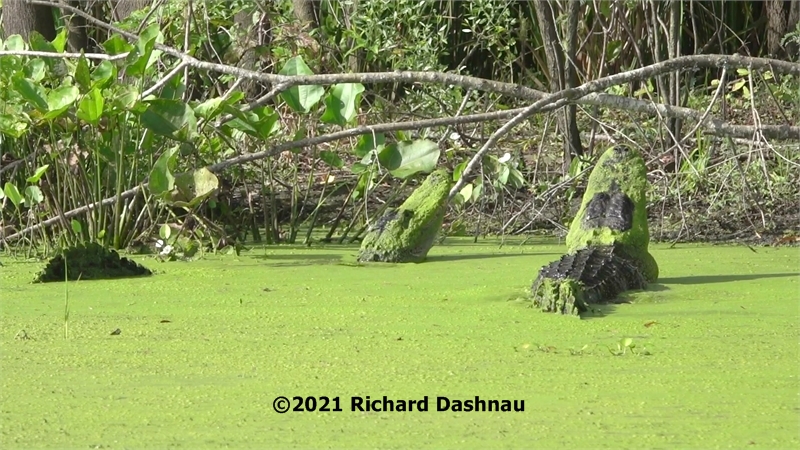
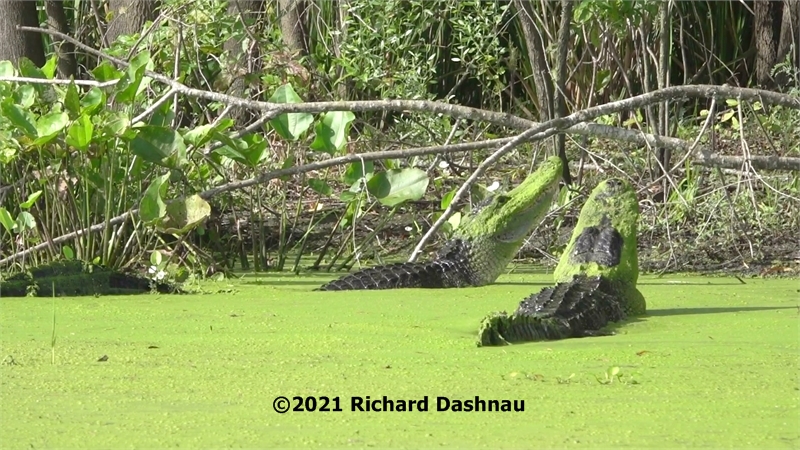
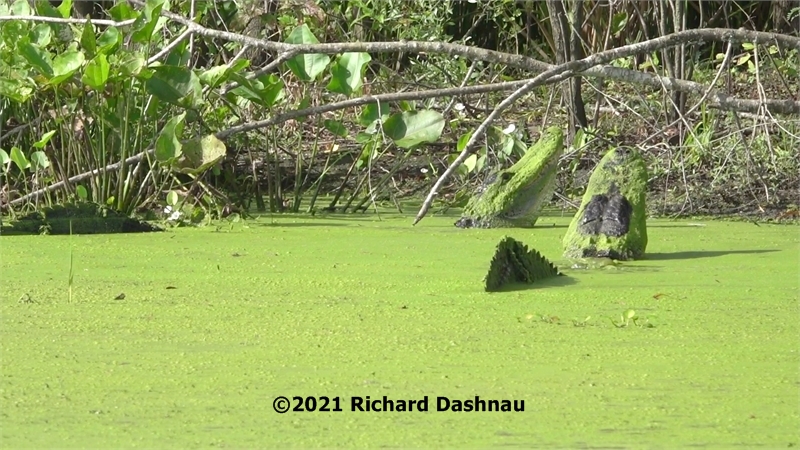
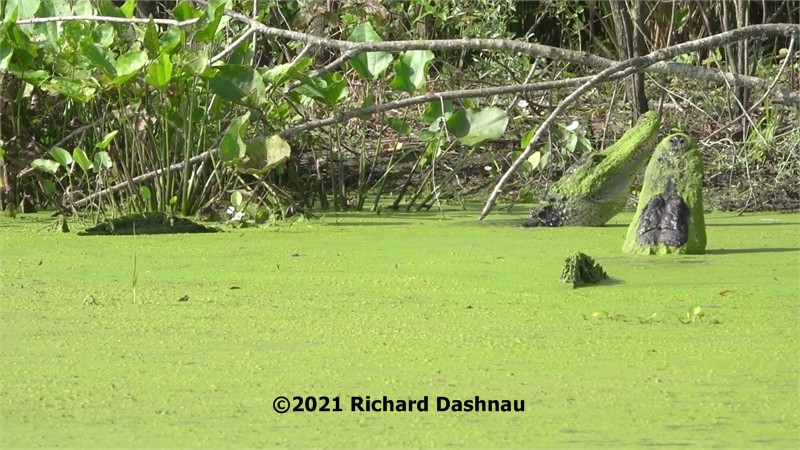
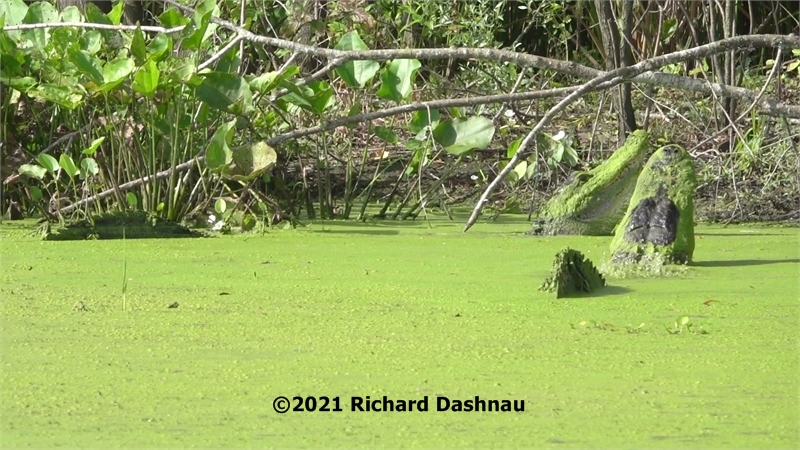
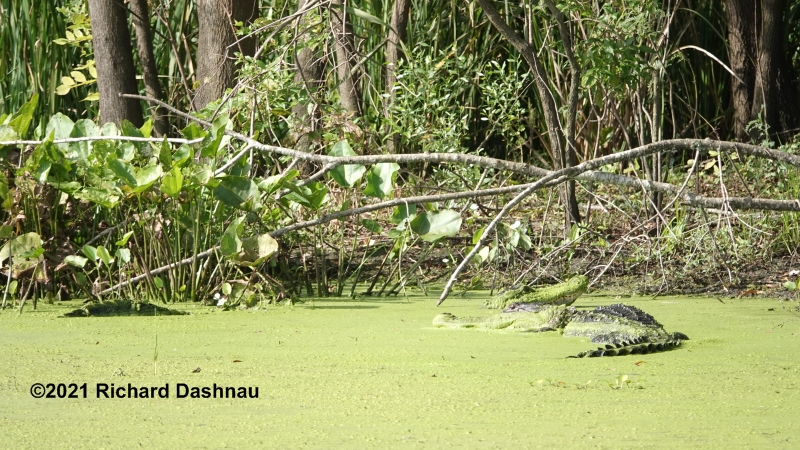
I remained in
the area until 11 or so, when I left to go visit Live Oak trail to
check on Apple Snail incursion (more on that, at another time, or check
this page).
05/02/2021 Even
with more "spare time"
it's taking me days to work on new material so I can post it. Part of
the reason is that I get more
new material before I've completed
editing of the previous new material--because I have more of that
"spare time" to go get the new material. Oh, darn. LOL
So,
here's how the alligator I described in the earlier post (further down
the page) got to be on the trail. I've put it all into this edited video. The images
below (with 2 exceptions)
are all frame grabs from the video.
At
about 8:45AM, this alligator crossed the trail and entered 40-Acre
Lake. When I got to its crossing point I saw this alligator
near
one of the islands. It was chewing on something.
The alligator that had crossed the trail swam across to this alligator.
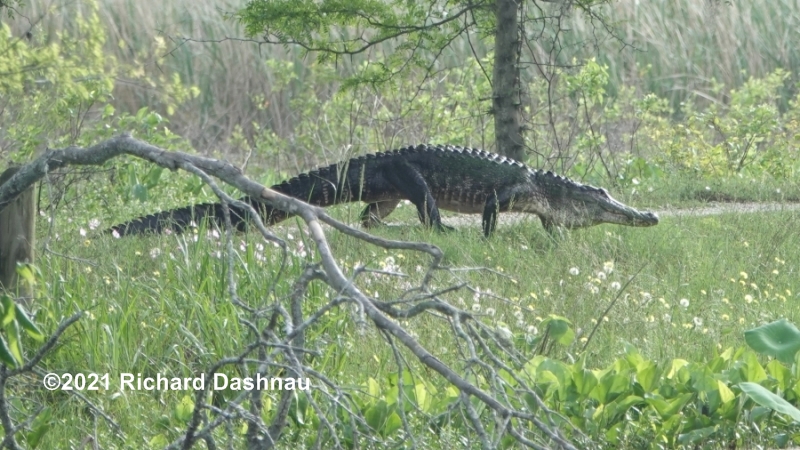
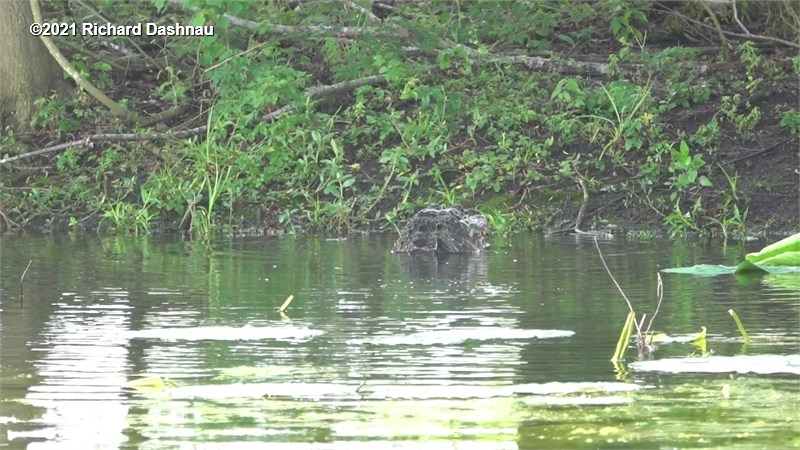
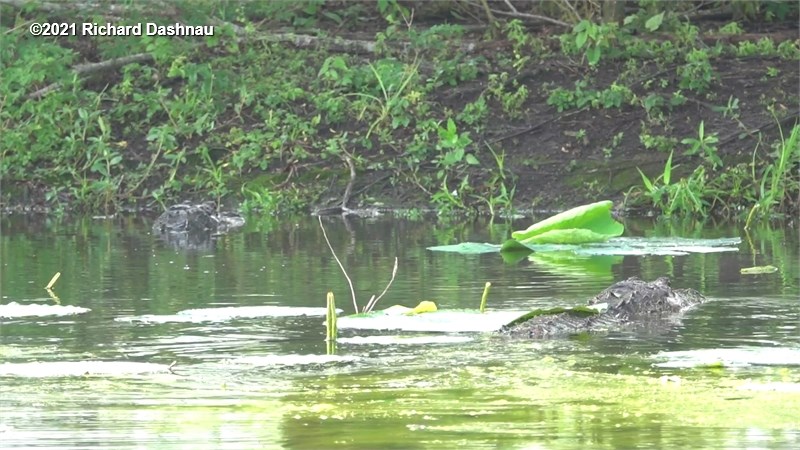
Alligator crossed the trail ahead of me.
This
alligator was chewing on
something.
This
alligator crossed the
trail and crossed to the island.
The
gator at the bank turned its head to watch the alligator that was
approching. I've seen many alligator contacts like
this. As
the distance lessened, the gator on the bank was being
challenged.
It could choose suddenly take off to the side, or quickly
turn
and rush the challenger or even escape onto the island. This
face-off continued, and NONE of those things
happened. Slow movement of the tail-could prepare
for burst of speed.
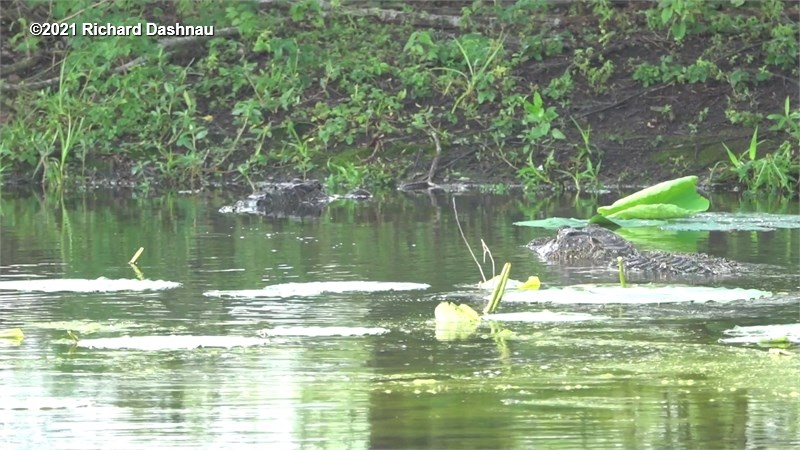
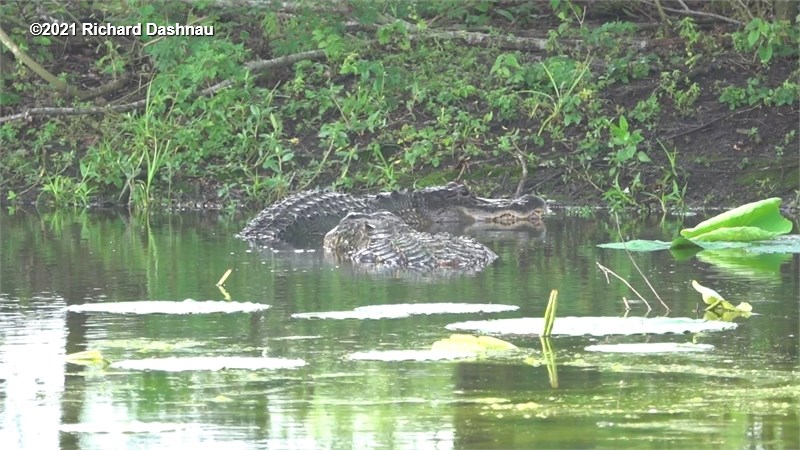
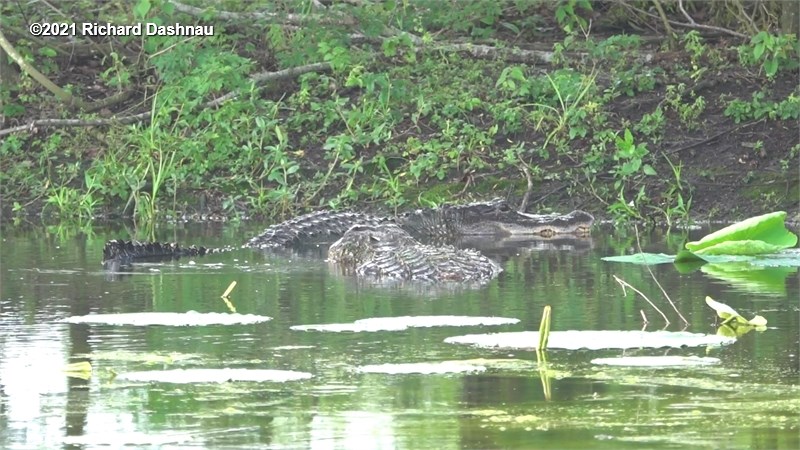
Stealthy
swim up to the resting gator.
Getting
even
closer.
Careful
movement of the tail
by the gator at the edge.
During
a close confrontation like this, both gators often move
carefully-neither escalating aggression or signalling submission.
Sometimes, something triggers a burst of quick
movement! In this
case, somehow the gator that I thought would be
dominated-wasn't.
The interloper backed off. It's very subtle, but the
"challenger"
allowed its body to sink,
lowering its back so it was underwater. The interloper turned
away, the "defender" turned toward it...and a chase began!
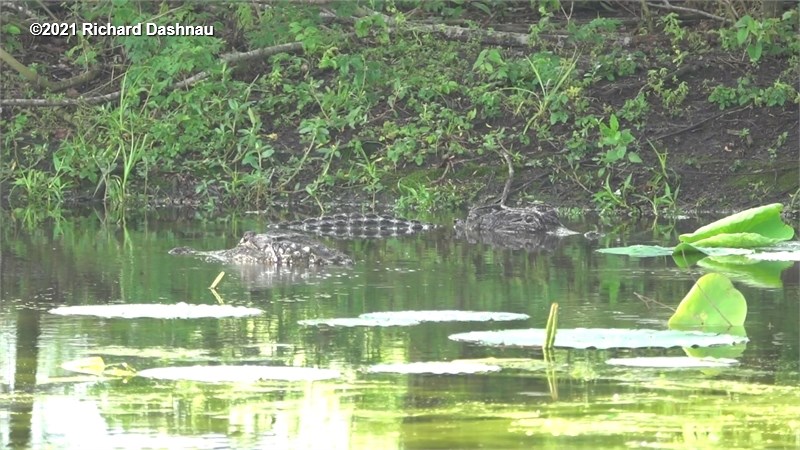
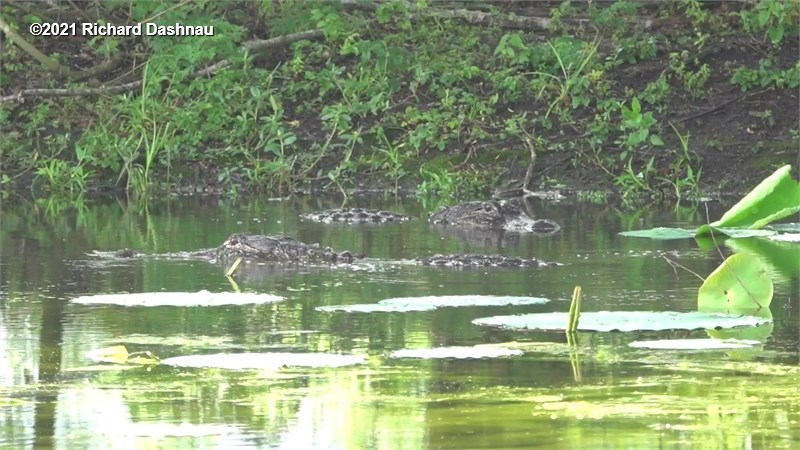
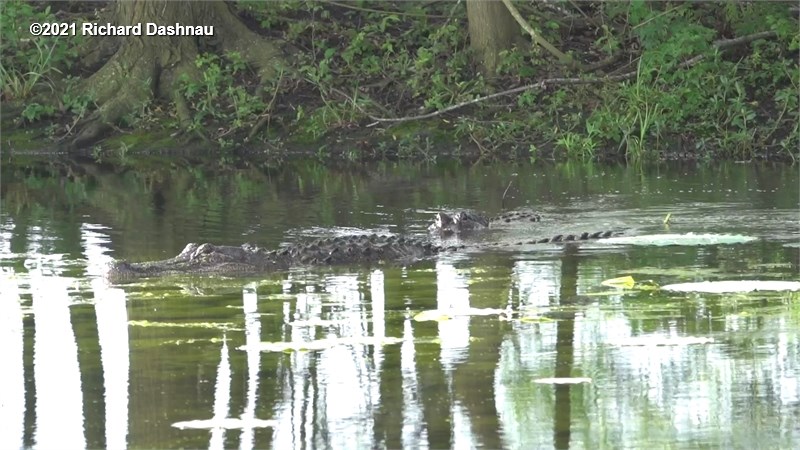
The rear gator lowered its back under the water.
The bigger gator backed
off, the smaller
gator turned... ...and then the smaller
gator
started chasing the larger!
Was
this a "catch me if you can" chase? Or a "get out of here
before
you get bitten" chase? Or something else? Swimming
speed
of both alligators increased. The gator doing the
chasing is smaller than the one being chased! I had
to walk quickly to keep up with them.
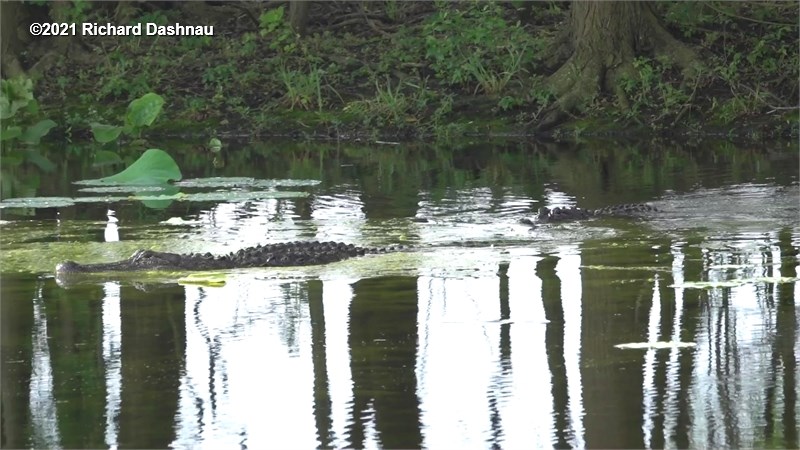
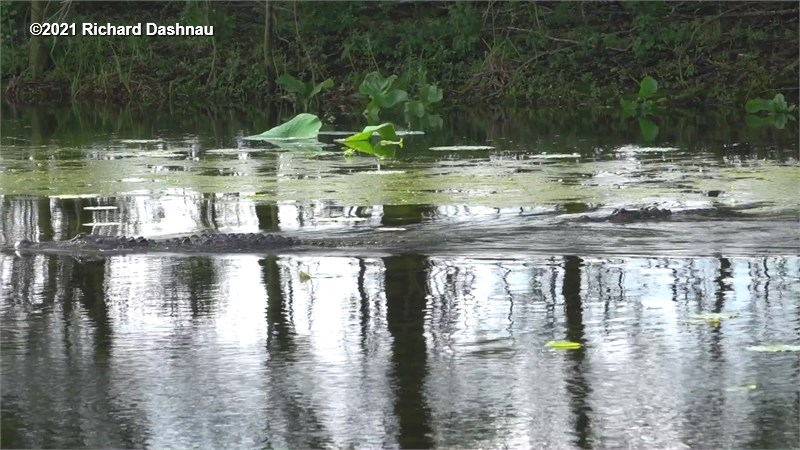
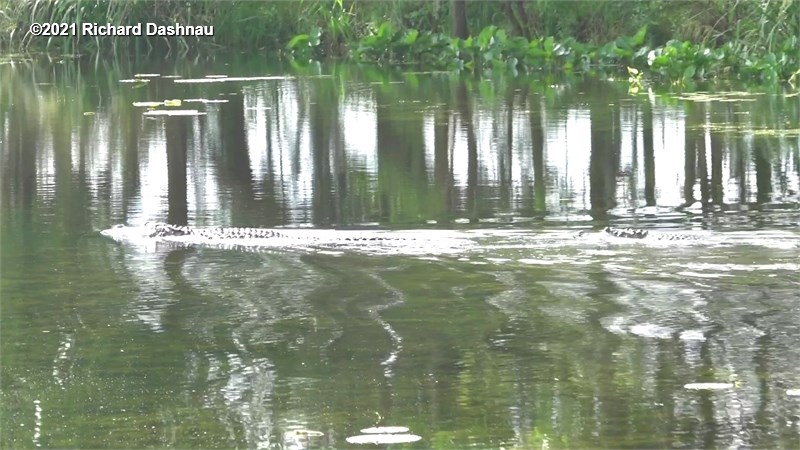
The
alligators moved faster....
...and
faster....
I had to walk quickly to
keep pace with the swimming gators.
The
smaller alligator stopped chasing, but the larger one kept
swimming. Alligator mating/courtship season is March-May; and
this was in May. The alligator stopped swimming about
20
yards in front of another alligator that was at the edge of the lake.
Alligators started bellowing Northwest--somewhere in Pilant
Lake.
When a chorus starts, I watch the gators
near me and look
for their reaction. But aside from a minor raise of the snout from this
one, not much visible reaction from these two. The alligator
in
the deep water started moving
toward the one on the bank. I
believe that the two alligators were aware of each
other. In
my experience, when there is a chorus of bellowing, a gator that wants
to join the chorus will
get into shallow water before
bellowing. The deep water gator moved a bit
closer.
The gator at the shoreline turned a bit, and the deep water gator
stopped.
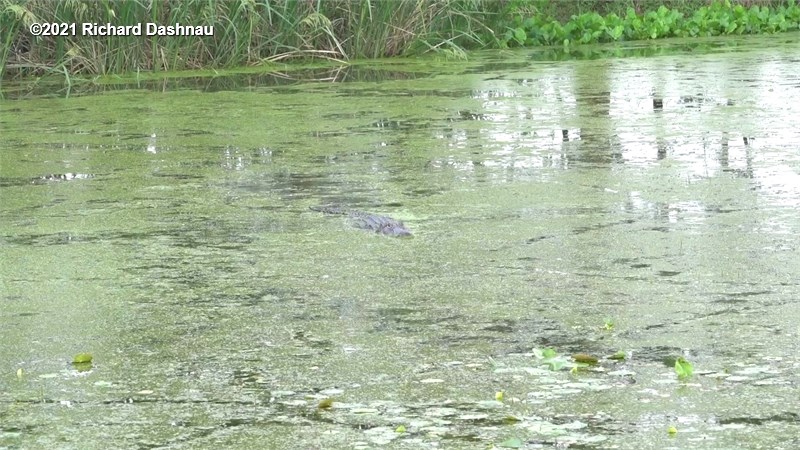
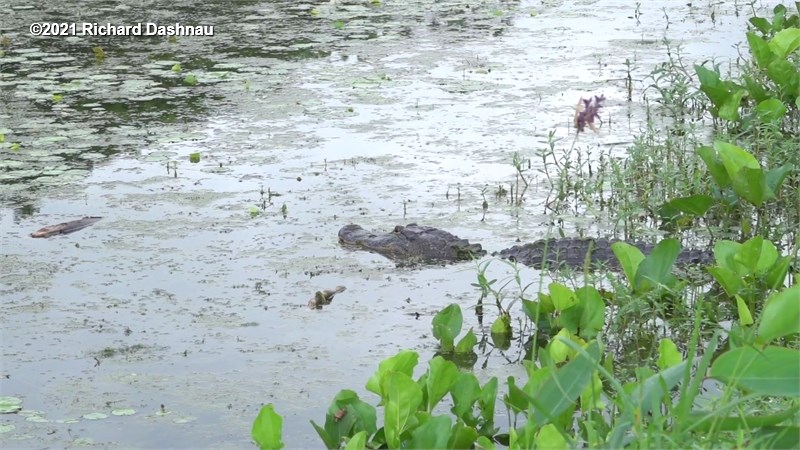
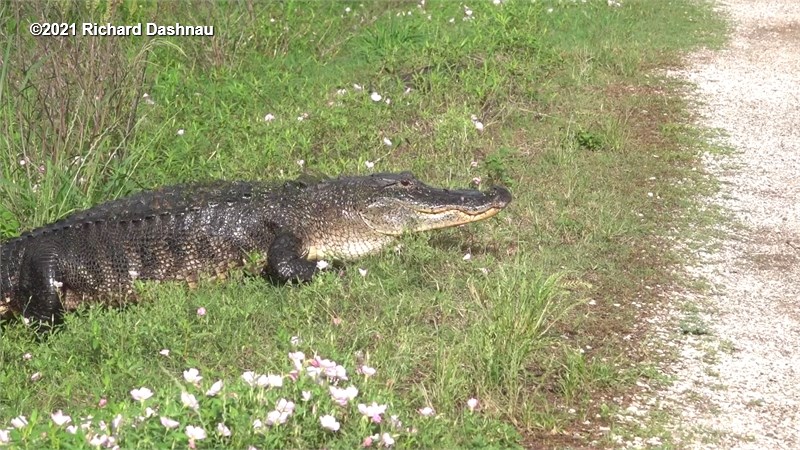
The
big gator stopped in front of....
....this
gator near the bank.
The gator at the
bank crawled up to the trail.
The
alligator at the shoreline climbed out of the water and up to the
trail. I really hoped to watch it cross the trail.
But
nope. I've seen many gators make the climb to the
trail just
to stop at the edge. Often, they rest a few minutes, then get
up
and continue across. Sometimes, they lift their hips and cloaca off the
ground and poop before continuing on.
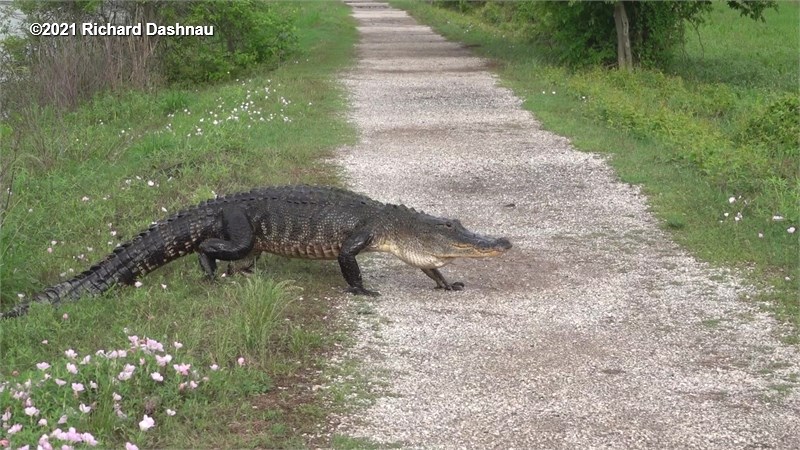

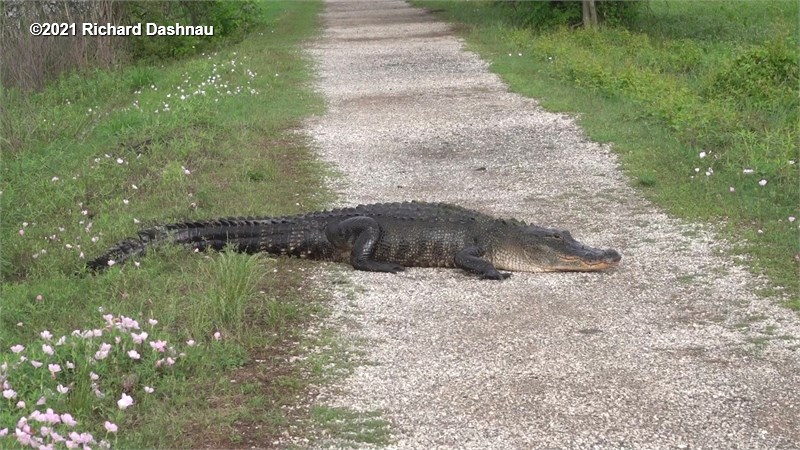
High-walk
onto the trail.
A
few more steps...
...and then down to rest.
The
gator flopped down to rest, while the other gator remained at the same
spot in the lake. I'm often asked if a gator is male or
female. One can guess based on some things . If
guarding
a nest or babies=female. If over 10ft long=male.
Back
vibration when bellowing=male. And then there's this
behavior,
which I've seen 2 other gators do some years ago
and which
shows that this one is a male. Gators don't flash people, and
they don't smirk. But it sure looked like it. I've
documented
this behavior once
in 2014 (scroll down to5/18/2014),
and once
in
2016 (scroll down to 3/27/2016),
on my web pages. Male alligator "junk" is extended by actions using
cloacal muscles. In this case, the alligator does seem to poop.
Not so in my other 2 cases. I'd found an article(link is still good)
describing the anatomy involved, and even emailed the author of that
study describing my observations. But they
could
give no direct reason for this behavior. And
that's how
the alligator ended up on the trail.--and how I was sure it was a male.
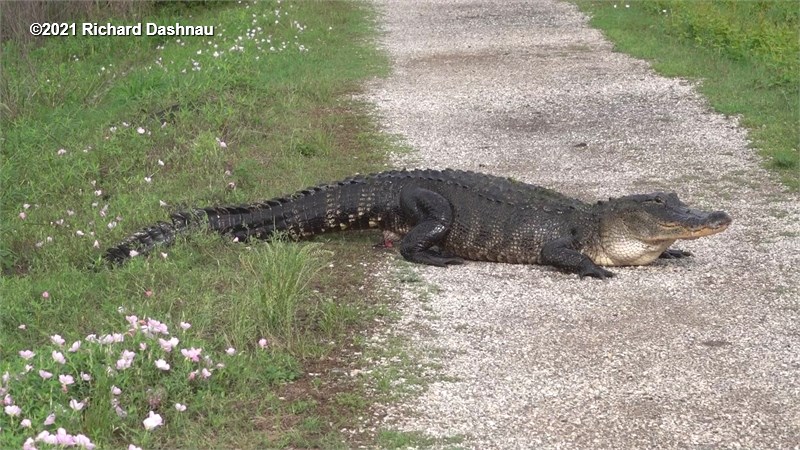
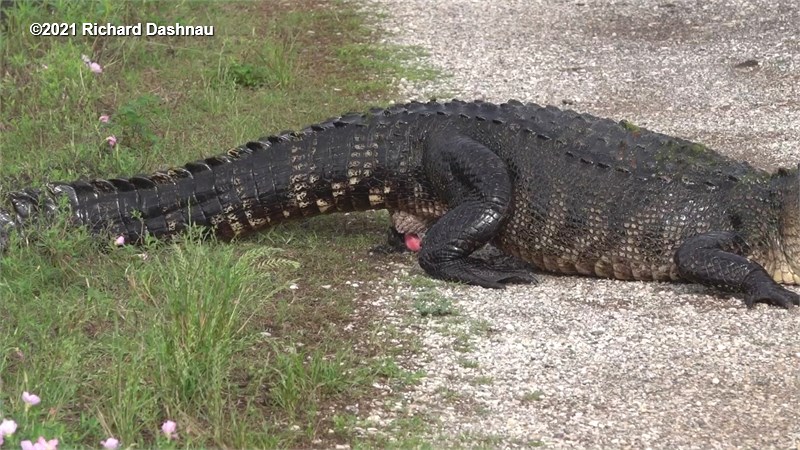
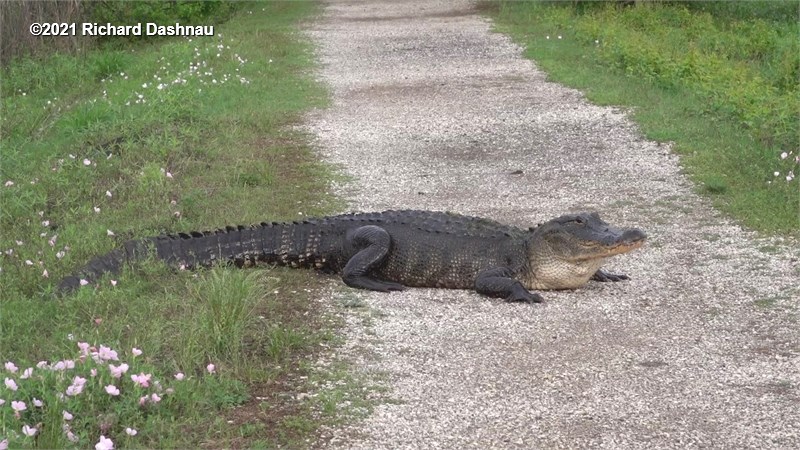
The
alligator lifted its cloaca up to poop.
The
gator also showed me that it was a male.
The alligator stopped for a while.
And,
this page shows
alligators at the park, on land, near various landmarks at the park.
Go back to my
main alligator page, Alligators
Go
back to my home page, Welcome
to rickubis.com
Go
back to the See
the World
page.


















































































